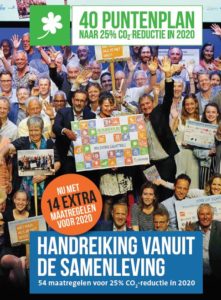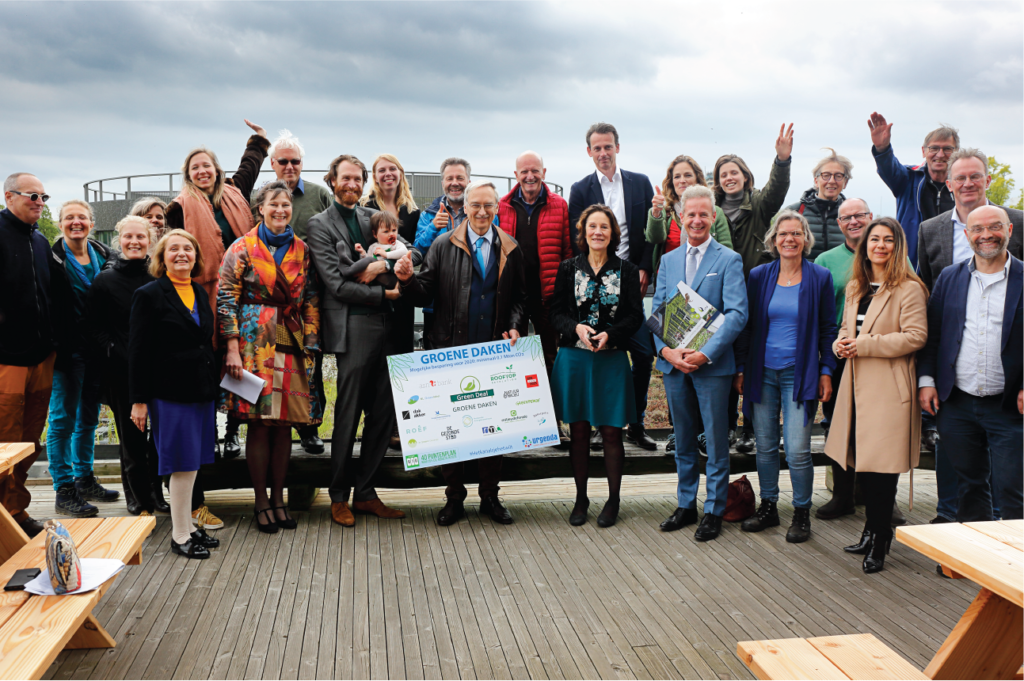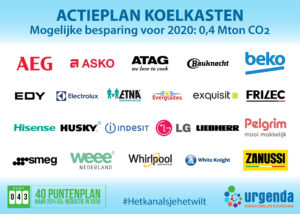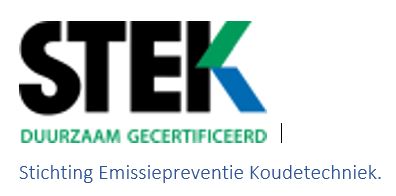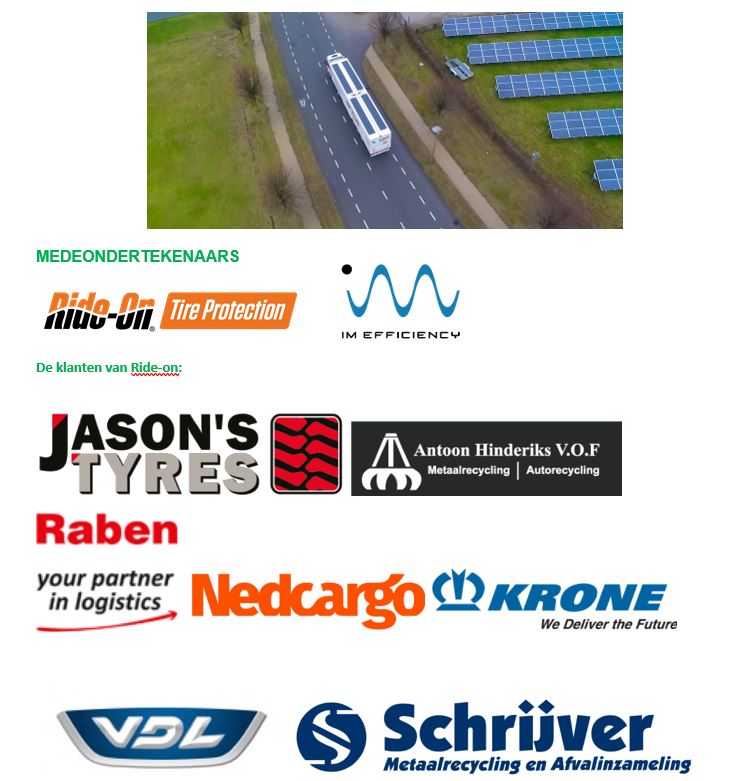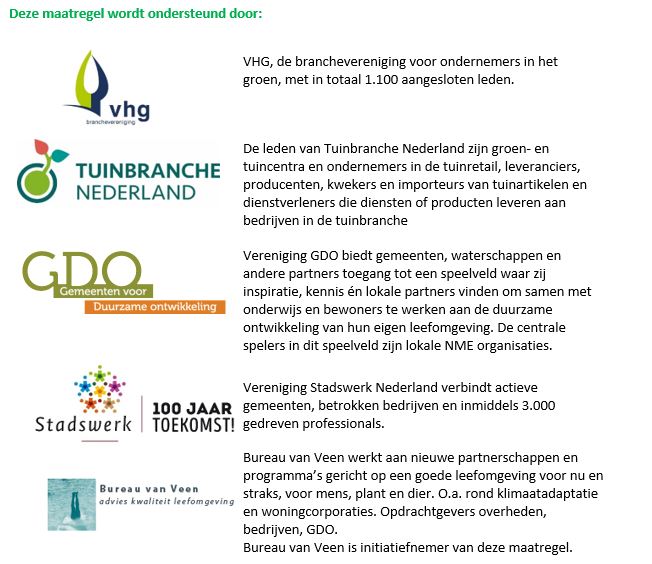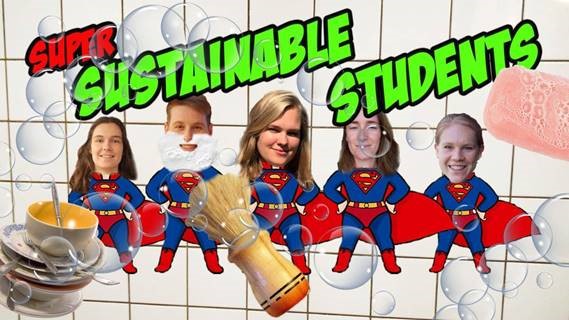The government now has less than a year to achieve a 25% reduction in CO2 emissions by the end of 2020, compared to 1990. With the 54 Climate Solutions Plan, Urgenda and 800 Dutch organizations offer a range of measures to help the Cabinet to reach its goal. There are still many possibilities, if action is taken now.
54 actions for 17 Mtons of CO2 reduction
In 2015, the Dutch court ruled that the Netherlands should reduce CO2 emissions with 25% compared to 1990 in 2020 at the latest (and all years thereafter). To implement the judgment the government took several measures, including the closure of a coal-fired power plant, the lowering of the maximum speed on highways and setting up several subsidy schemes for renewable energy and energy efficiency measures. However, the resulting reductions still fall short of what is actually necessary.
To provide the government a helping hand, Urgenda started working on a CO2 reduction plan with the help of 800 Dutch organisations. The result: a plan with 54 climate actions that are affordable and supported by a large part of the Dutch population. The total plan reduces CO2 emissions by 17 Mtons, enough to ensure compliance with the judgement of the Supreme Court.
3 billion euro plan to save energy in households & industries.
On April 24 2020, the Dutch government announced its plan to comply with the historic ruling of the Dutch Supreme Court in Urgenda’s climate case against the government. Despite the government’s significant delay, its impressive plan will meet the court’s order, with a possible delay of a few months. In part, the government has opted for the cheapest and easiest measure: reducing coal-fired power station capacity. In addition, the government is implementing dozens of smaller measures which, although more expensive, have many positive side effects, such as lower energy bills for citizens, more biodiversity and cleaner air. About 30 of these measures are lifted from Urgenda’s ‘54 Climate Solutions Plan’.
Some measures were taken after the first version of the plan was launched June 2019. Now the government is going to implement more measures, adding up to more than 30 measures that are implemented partly or fully. In total, the government will spend more than €3 billion, including €2 billion for large scale solar projects that are ready to start this year.
The measures that will be taken include:
- €2 billion for more renewable energy, mostly roof-top solar (54)
- Maximum speed-limit reduced from 130km/h to 100km/h during daytime hours (3)
- €60 million to reduce the pig herd and €300 million to reduce other livestock numbers (dairy cows/meat calves/sheep/goats/chickens) (2, 22, 53)
- €10 million for more sustainable concrete in road-building projects (37)
- €30 million for LED lighting in greenhouses (24)
- €300 million to save energy in households, including insulation, solar boilers, double glazing, stand-by savers, CV optimisation etc (14, 15, 26, 29, 34, 41, 42, 43 en 46)
- Reform of particular laws and regulations that will result in more renewable energy (9, 21)
- Better recycling of plastics and refrigerators (32, 43, 47)
- More sustainable forest management; more trees and forest (7, 35)
- More inspections and better enforcement of environmental laws (5, 8, 13, 24, 44)
- Solar panels on government buildings and schools (20, 23)
Solution 1 - 100,000 rental houses energy neutral - 0.2 Mton
100,000 rental houses energy neutral
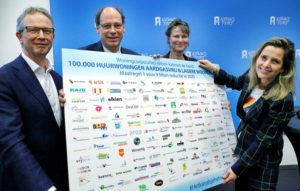
This first measure results in almost 100,000 energy-neutral homes with a (very) small energy bill, and tenants benefit from day one. The housing corporations can pay that with the amount that they now pay the government in taxes because of the so-called landlord tax. This was a temporary tax measure, incorporated in 2013, that has never been stopped and will amount to 2 billion in the coming year. Two months’ rent of every tenant go straight to the treasury. In recent years, two other taxes have been added, resulting in 4 months’ rent to flow to the government each year.
Climate Solution 1 suggests that the government cancels the landlord tax under the condition that the money is used to make houses energy-neutral. This will mean that the tenants receive a much lower energy bill immediately after the renovation is completed. Their profit/savings could go up to 50-70 euros per month.
Apart from saving 0.2 Mton CO2 emission, this will cause a priceless increase in public support for climate policy.
REDUCTION 2020: 0.2 MTON
REDUCTION 2021: 0.4 MTON
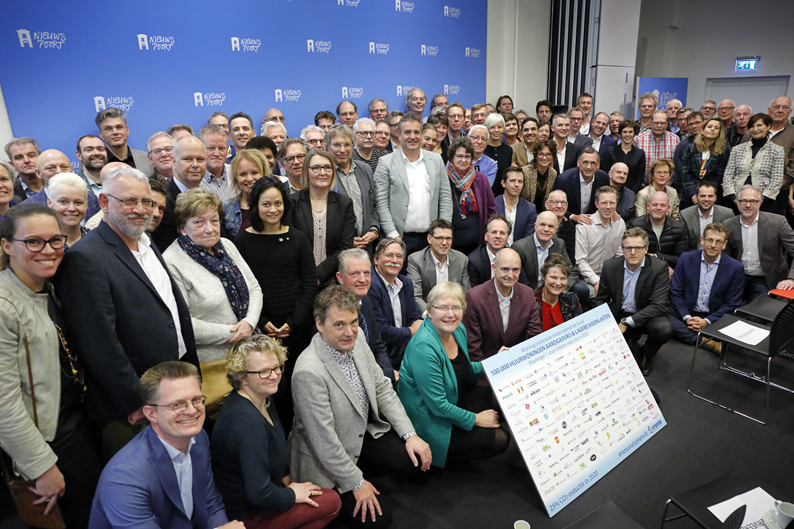
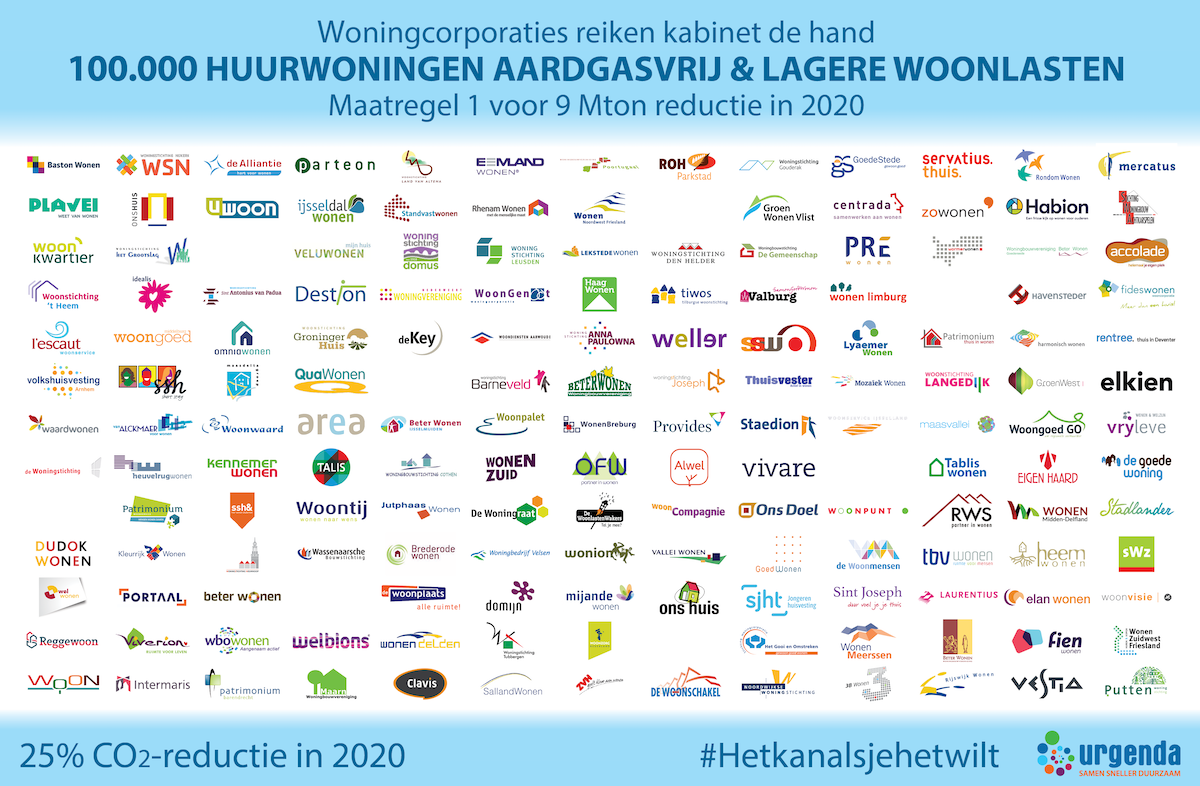
Solution 2 - Fewer cows, same profit - 2 Mton
Fewer Cows, same profit
The second measure is a 30% decrease in the Dutch dairy industry, either in animal numbers or in milk production. This would result in a reduction of 3 megatons of CO2 eq per year. After the closure of the coal-fired power stations, that is one of the largest measures that can still be taken for the climate.
It also can greatly improve biodiversity. Most importantly, this measure does not intend that the farmers pay the bill. They have already been suffering from continuous changing policies over recent years.
Yet there is a good reason to have another look at the number of cows, because if we do not do that ourselves, then Brussels will probably force the Netherlands to take far-reaching measures. The Netherlands emits too much nitrogen and phosphates, both of which ensure that they do not meet the EU standards that the Netherlands has signed up for.
Nitrogen, of which dairy farming is the largest source, has negative effects on nature reserves, insects, soil life and health. To strongly limit EU standards and the negative effects in 2030, we will certainly have to reduce by 30%: less (artificial) manure, less concentrate and therefore fewer cows or much less milk per cow. To prevent a repetition of 2016, when 160,000 cows suddenly had to go to the slaughter because we did not meet the EU standards for phosphate, we can now take matters into our own hands and make changes in 1.5 years, without the farmer receiving less income.
Part of the solution can lie in having cows produce less milk. Cows now produce an extremely high amount of milk, which can be reduced by 15 to 20% through concentrate reduction and fertilizer reduction. The remaining 10% reduction will then have to come from a shrinking of the herd and the choice of other cow breeds. Research shows that fewer cows and a better balance between the number of cows and the amount of land not only leads to lower production, but also to considerably lower costs. On balance, the farmer does not have to suffer loss. This offers prospects for more dairy farmers.
If we want to make such a big change within two years, then we will have to help farmers, with knowledge and financial support to compensate for the temporary loss of income. There are plenty of good examples that deserve good follow-up. Now a lot of money has been set aside to tackle the nitrogen problem, including € 2.2 billion for improving nature quality alone. Let’s use this for a nature-friendly dairy industry that incorporates nature rather than ruining it.
REDUCTION 2020: 2 MTON
REDUCTION 2021: 3 MTON
Solution 3 - Lower the maximum speed on highways - 0.8 Mton
Lower the maximum speed on highways
A simple but powerful measure can be to lower the maximum speed. It is also a measure that the government can take relatively quickly, at very low cost. It is up to the government how difficult or easy they want to make it for themselves.Simply going back to 100 km/hour on highways and to 80 km/hour on roads will result in a 1.2 Mton (megaton) CO2 emission reduction.
Driving more slowly has many more benefits: fewer casualties, fewer traffic jams and reduced air pollution.
The Dutch government has decreed that maximum speed is limited to 100 km on highways from March 2020 onwards. However, between 19pm and 6 am, driving 120 or 130 km/hour is still permitted, leaving vast room for improvement.
REDUCTION 2020: 0.8 MTON
REDUCTION 2021: 1.2 MTON
Solution 4 - Saving energy in healthcare institutions - 0.2 Mton
Saving energy in healthcare institutions
The government can encourage healthcare institutions to participate in the ‘Energy Challenge’, a Urgenda campaign that lowers the energy bill of participating institutions with 10-15% on average. In recent years, at least 70 care homes have entered the competition and by simple behavioural changes (closing doors, turning off lights), a significant reduction of energy use is accomplished. On top of that, simple improvements of the heating installations are suggested.
The government can save 0,2 Mton CO2 emission by handing out vouchers to scale-up this campaign to 1900 care institutions.
The ‘Energy Challenge’ has been received by the institutions and its residents as positive and fun and not as an imposed measure. The institutions save thousands of euros each year, which they can use to improve their care standards.
REDUCTION 2020: 0.2 MTON
REDUCTION 2021: 0.2 MTON
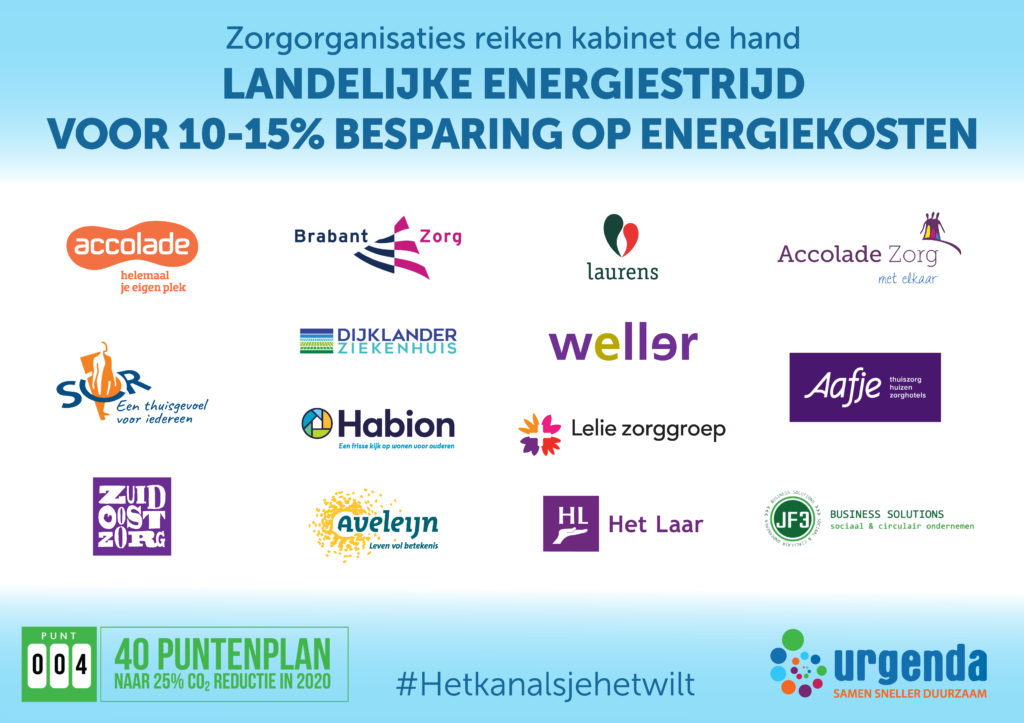
Solution 5 - Switch of the lights after working hours - 0.2 Mton
Switch off lights after working hours
Shops and offices still too often leave unnecessary lights on after working hours, sometimes even on the weekend. It was previously calculated that 536 million kWh of electricity can be saved by switching off unnecessary lighting outside of operating time. That saves 0.36 Mton per year in CO2 emissions.
A timer, sweep switch, motion detection or simply making someone responsible for it, works wonders and is easily earned back. The government has several options:
- Copy French legislation: order lights to be switched off after work hours and fine companies that don’t.
- An informative campaign on the subject, focusing on the savings aspect.
REDUCTION 2020: 0.2 MTON
REDUCTION 2021: 0.3 MTON
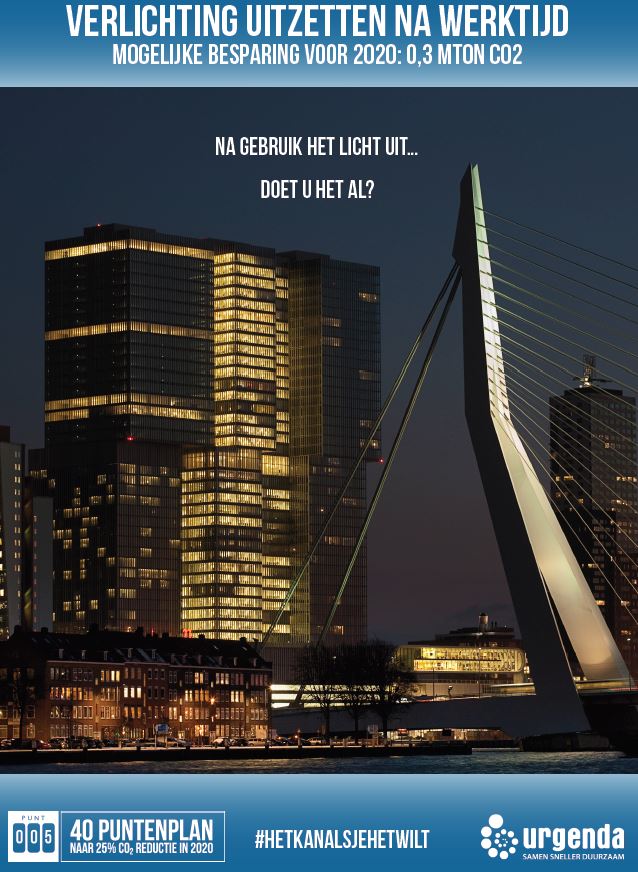
Solution 6 - A network of semi-autonomous small vehicles - 0 Mton
A network of semi-autonomous small vehicles
There are a lot of delivery vans that together emit 5.3 Mton CO2 per year and form a very inefficient form of distribution. Part of these emissions can be eliminated by driving with semi-autonomous electric vehicles, running at the speed of a walker to jogger (5-8 km / h) and the size of a low ice cream cart (80-100 cm wide, up to max. 2 m long, max. 750 kg) driven on the right in the countryside, in holiday parks and industrial sites, and transporting things that are not in a hurry.
The vehicle is full of sensors and learns to drive fixed routes. If there is an unexpected obstacle, it will stop until told otherwise by a person who has remote control.
A Dutch innovative company, MWLC, has developed a prototype vehicle and has done several successful demonstrations at a holiday park on the island Ameland. The company now awaits permits to deliver chilled goods to a local company. The use of semi-autonomous electric cars is much cheaper than electrifying existing delivery vans, by a factor of 3-6 times cheaper. It will take quite some effort for the government, but on the other hand: the CO2 reduction is large and the Netherlands could be an international innovator on this subject.
What is needed:
- Legislation to allow experiments
- Clear and realistic criteria
- An innovation fund of 200 million euro to experiment and scale up
REDUCTION 2020: 0 MTON
REDUCTION 2021: 0.5 MTON
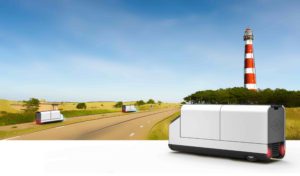
Solution 7 - Sustainable forest management - 0.2 Mton
Sustainable forest management
Trees and forests capture a lot of CO2. Trees and forests are also extremely important for biodiversity. It is therefore important that we treat our forests and trees with care and strive for natural forests with a varied uprising of native trees and shrubs.
Yet many trees are cut down. Sometimes that is not a problem, for example when cutting is done because trees are sick, to exchange monotonous production forest for natural forests or to preserve other nature.
In recent years, however, a lot of forest has disappeared: the Dutch deforestation rate was larger than in the Amazon rainforest. A lot of wood has been disappearing into biomass plants and clearcutting has returned as a management measure to harvest and cultivate wood. Where it used to be the case that a maximum of 1% of Dutch forests were cut to make way for young trees and wood collection, in recent years 2% have been cut. Each time, a piece of forest of about 0.5-2 hectares is cut down. With this method, young trees that are 10-30 years old and aren’t yet suitable to use for planks, are being cut down too. The litter layer is removed and replanted, resulting in significant loss of biodiversity and of carbon from the soil, leaving the soil with fewer nutrients for new trees to grow on.
A more sustainable forest management that does not clear-cut hectares at a time, but only targets specific tall straight trees for optimum wood collection, leaves the soil and biodiversity intact. Sustainable forest management can save 175,000 tons of CO2 annually.
After much media tumult and public complaints from tens of Dutch NGOs that all support Climate Solution 7, the minister announced a new Forest Strategy. Although the strategy is not finalized yet, as of April 2020 the maximum cutting area is set at 0.5 hectares, allowing the forest area to grow again. Biodiversity and climate change are considered to be the priority issues.
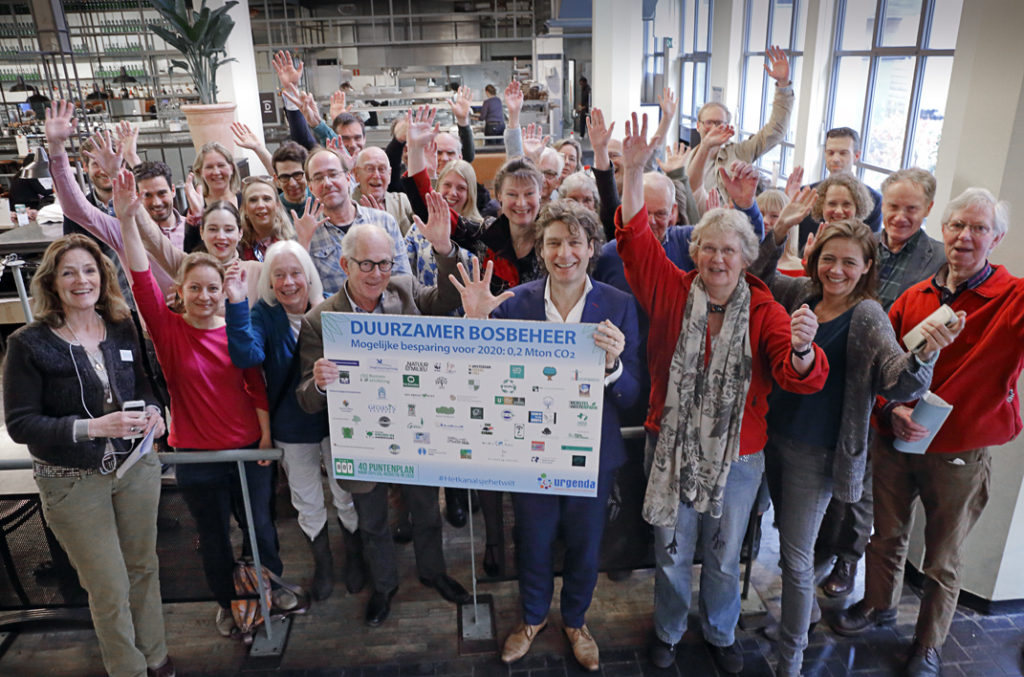
Measures to be taken:
- Stop the clear-cutting of stretches of forest as a method of timber harvesting or as a rejuvenation measure; cut only the straight trees that yield the most wood and let the other trees grow old and die;
- Stop working forest soils; as a result, less CO2 will evaporate and the soil will remain healthy;
- Stop the extraction of biomass from the forest, with the exception of ecologically sound disposal of trunks for sustainable use;
- Stop harvesting trees for energy purposes.
REDUCTION 2020: 0.2 MTON
REDUCTION 2021: 0.2 MTON
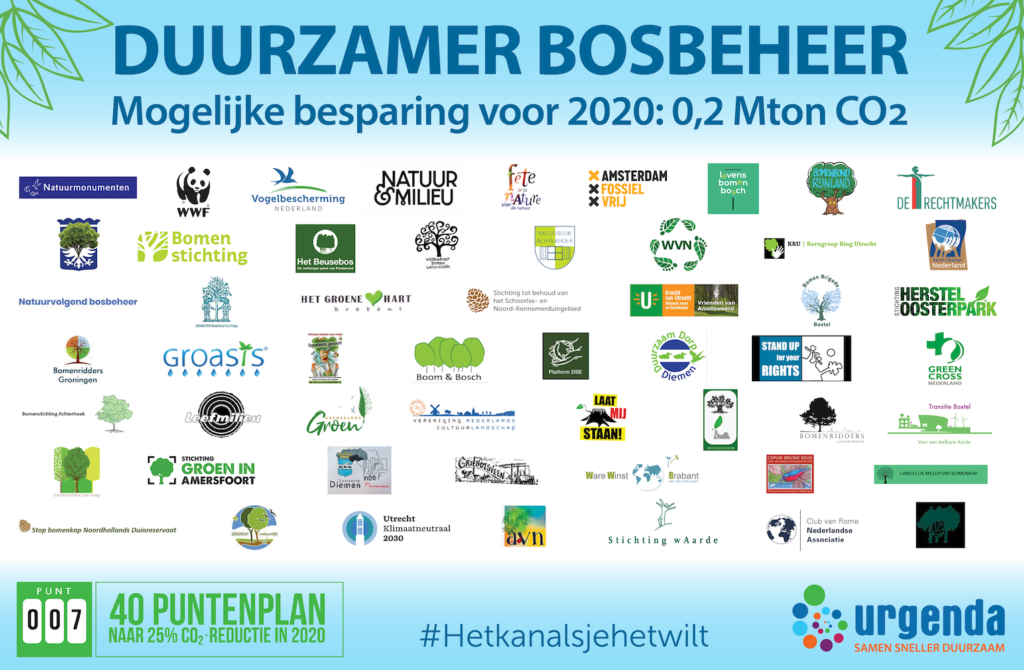
Solution 8 - Limit government tenders to compliance with environmental law - 0.3 Mton
REWARD FRONTRUNNERS WHO COMPLY WITH THE LEGAL OBLIGATION TO SAVE ENERGY
The Environmental Management Act has had an energy saving obligation since 1993. This energy saving obligation is defined as the obligation for organizations to take all energy saving measures that have a payback time of five years or less.
Not many companies and institutions comply with this legal obligation. The government does not keep proper track of the organizations that do. In other words, it does not properly uphold this law. That is a shame, because the government could and should reward those who do comply by allocating assignments to them.
The government can accelerate and increase energy savings by companies (thereby saving at least 0,4 Mtons of CO2 emissions) by linking tenders to companies that comply with the Environmental Management Act.
REDUCTION 2020: 0.3 MTON
REDUCTION 2021: 0.4 MTON
Solution 9 - Maintain current regulations for solar panel owners - 0.4 Mton
Maintain current regulations for solar panel owners
Fortunately, the government has already decided that ‘net metering’ (a billing mechanism that credits solar energy system owners for the electricity they add to the grid) will not stop in 2020 or 2021, but will be continued until 2023 and then be gradually phased out.
That’s important because it provides certainty and gives people the confidence to invest in solar energy again. This is necessary for the solar energy market to grow even faster.
In 2018, Solar PV grew with more than 1.4 GWp and in 2019 with 2,4 GWp. If this continues in 2020, we will reach a growth of 9 GWp by the end of 2020 (estimate Dutch New Energy Research), higher than the government’s goal.
A commitment to continuation of net metering will lead to at least 1 GW of extra sun power compared to the existing targets. This leads to an additional reduction of approximately 0.4 Mtons of CO2 (calculated with the Energy Transition Model).
REDUCTION 2020: 0.4 MTON
REDUCTION 2021: 0.4 MTON
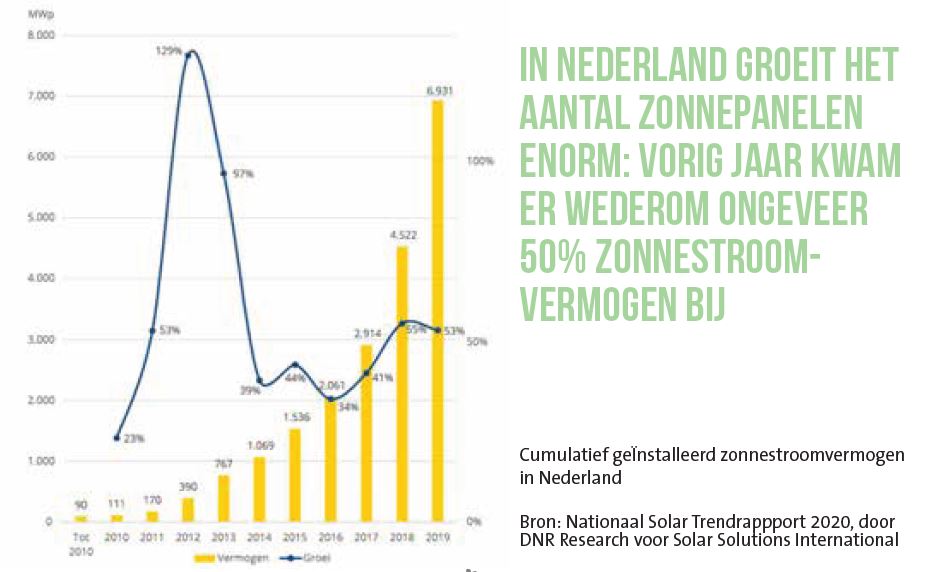
Solution 10 - Green roofs - 0.1 Mton
Transform 10% of Dutch roofs into green roofs
Green roofs have many benefits that have been researched thoroughly: cleaner air, more insects, cooling, decreased painkiller use and many more benefits. And to top it all off, it also delivers CO2 savings.
This pleasant solution prevents CO2 emissions in summer, as green roofs have a cooling effect. They save energy by making airconditioners redundant. A grass or herb roof with a more robust layer of vegetation also saves heating in the winter, some studies say. On top of that, plants store carbon and green roofs improve the efficiency of solar panels on hot days, because they keep their surroundings cooler.
‘De Geodienst’ of the University of Groningen calculated that the flat roof surface of the 9 largest cities combined is already greater than 40 square kilometers. If we install green roofs on all of these surfaces, we can save at least 0.1 Mtons of CO2. If we also opt for natural roofs or a combination with solar panels, the savings will increase.
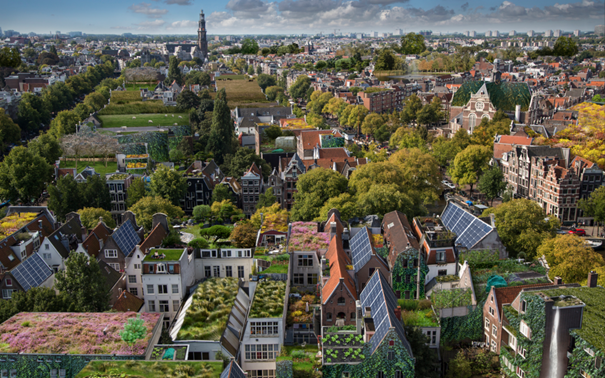
This is what Amsterdam could look like, too. – Source: Alice Wielinga in opdracht van Rooftop Revolution
REDUCTION 2020: 0.1 MTON
REDUCTION 2021: 0.2 MTON
Solution 11 - Vegetarian meals one extra day a week - 0.5 Mton
Reduce meat consumption
If all Dutch people follow a vegetarian diet for one extra day a week, Dutch CO2 emissions will be reduced by 0.5 Mtons per year. The Dutch guidelines for healthy eating prescribe three vegetarian days a week, which, if implemented by everyone, would save no less than 1.5 Mtons pers year.
Our Western meat consumption has a major negative impact on the climate, the environment, our health, biodiversity and on local communities in soy producing countries.
This is precisely the reason why large institutions such as the United Nations, the Netherlands Nutrition Center and RIVM have been advocating reduced meat consumption for some time.
This is also the reason why 30 organizations – from Animal Protection, Doctors & Lifestyle to Oxfam Novib – are now asking the government to introduce measures as quickly as possible to help consumers opt for vegetable meat substitutes more often: a financial incentive on meat that is set in such a way that it does not affect those on lower incomes and the proceeds of which are used to help farmers to become more sustainable. Research shows that such an incentive will save millions of euros in health care.
REDUCTION 2020: 0.5 MTON
REDUCTION 2021: 1.0 MTON
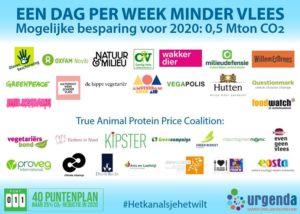
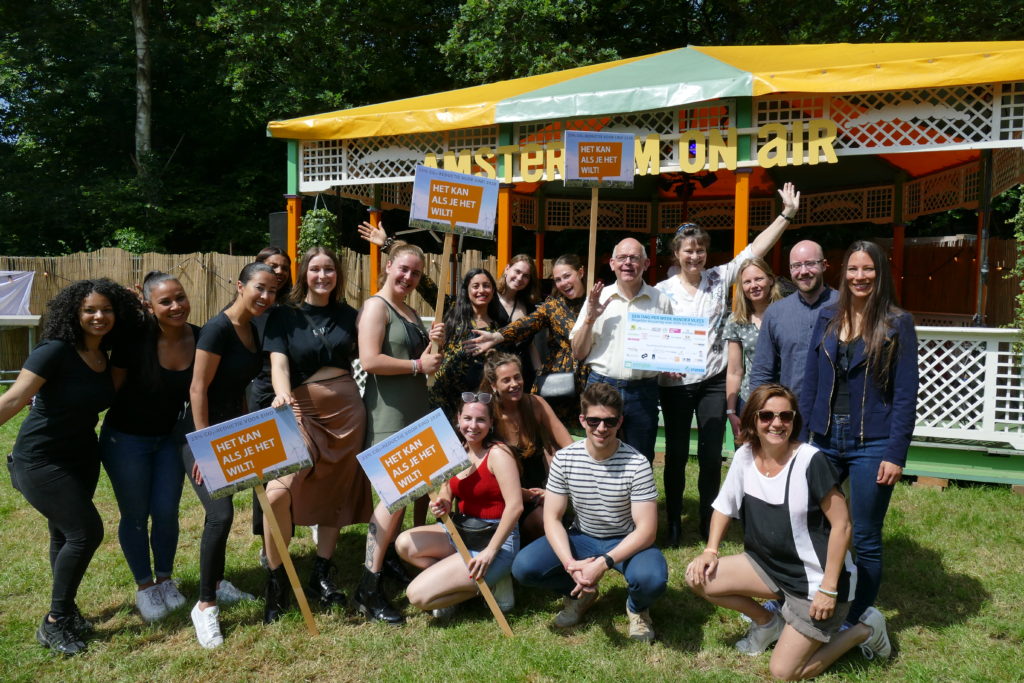
Solution 12 - Accelerated raising of groundwater level in peat meadows - 0.2 Mton
Accelerated raising of groundwater level in peat meadows
By raising the groundwater level in peatlands and creating more nature, the Cabinet can save 0.2 Mtons of CO2 by the end of 2020. The Cabinet’s plans for 2030 to raise the water level in peatlands can be implemented at an accelerated rate. In the coming year it will be possible to start wetting the peat within current nature reserves, and new areas can be purchased sooner.
This CO2 reduction measure is relatively cheap and has a major additional advantage: in the short term, more habitat will be created for many animal species that are currently seriously deteriorating. This way, climate and nature objectives are tackled integrally.

REDUCTION 2020: 0.2 MTON
REDUCTION 2021: 0.4 MTON
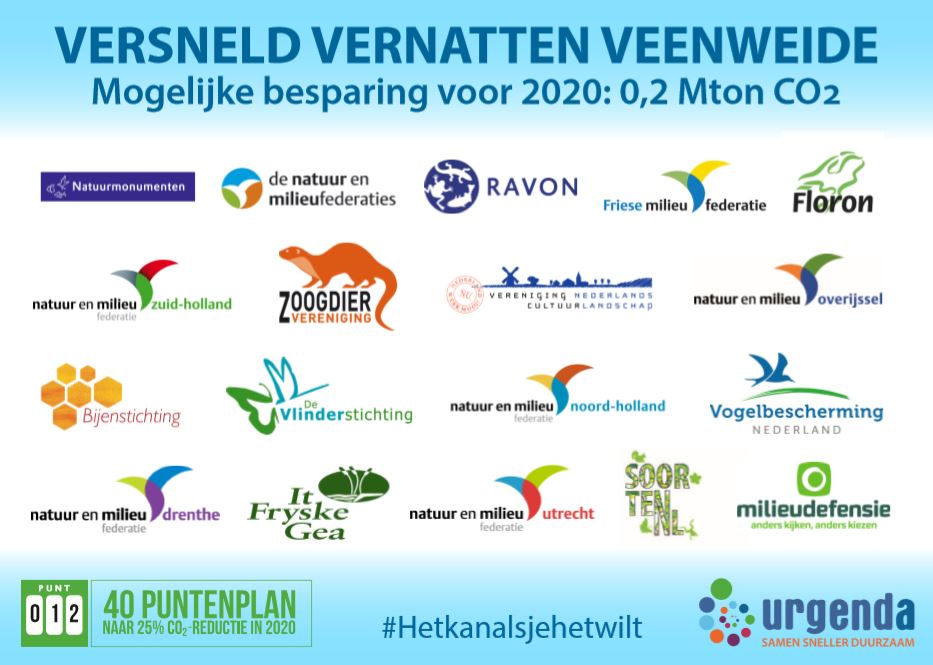
Solution 13 - Action programme for electric motors - 2 Mton
Action programme for electric motors
Electric motors consume almost 70% of industrial electricity. The Energy Research Centre (ECN now part of TNO) calculated a realistic reduction of 3.78 Mtons of CO2 through a system approach (a combination of better motors, better adjustments, speed and frequency control, etc.) for the industrial and service sectors. ECN does not yet take into account the potential of non-contact magnetic couplings: a promising innovation in electric motors that can deliver significant additional savings. A concrete action plan for electric motors, including magnetic coupling, should be able to save at least 2 Mton CO2 before the end of 2020.
Virtually all applications with rotating and moving parts are driven by electric motors. It is therefore not surprising that electric motors are responsible for 53% of global electricity consumption. It is estimated that almost 70% of the total industrial electricity consumption is consumed by electric motors. In the services sector, this percentage is around 38%.
An electric motor is a relatively simple device and often relatively easy to make more efficient. Many electric motors drive pump, compressor and ventilation systems. These consume 70% of the industrial electricity consumption (ECN, April 2017, p.19). They last a long time and therefore many outdated systems are still running, while improvements in this area often pay for themselves very quickly. An electric motor is classified in a so-called IE class. IE1 is an electric motor with a ‘standard efficiency’; IE5 is ‘very efficient’ but hardly commercially available yet.
The EU (on the basis of the European Ecodesign Directive) often requires a large group of motors to be at least IE2 or IE3. Motors with EI4 receive a subsidy for energy investment allowance (EIA) in the Netherlands. However, many old motors are still running. ECN shows that the savings depend on the power of the motor, among other things. For example: replacing an IE1 1 kW motor with an EI3 motor saves 13% energy; for a 10 kW motor it is 6%. Most investments in a motor of a higher class pay for themselves within two years. For many companies it is therefore a legal obligation to take that step.
There are also all kinds of other measures that can be taken, such as:
- a speed or frequency regulator;
- system approach and thus optimize flow systems;
- contactless magnetic couplings.
The ECN report of 2017 estimates that a system approach (combination of better motors, better adjustment, speed and frequency controls, in combination) could lead to 9.1 TWh savings for industry and services. It has not yet been calculated what additional savings could be achieved by non-contact magnetic couplings. Zytec, a company that supplies these couplings, sees a potential of 9-12 Mton, but now calculates cautiously with 2 Mton. A recent brochure by FME, the business association of the technology industry, also discusses measures that can be taken now, in which the magnetic couplings are included. In their Project 6-25, industrial parties want to reduce CO2 emissions by 6 Mton by 2025, mainly through efficiency measures. This can be achieved with proven technologies. The savings will also ultimately result in many billions of cost savings for the companies.
Measures to save an additional 2 Mton by the end of 2020
According to the law, companies have to take all the energy-saving measures that will pay for themselves within five years. This applies to most modifications in the field of electric motors, from purchasing more efficient motors to the previously mentioned system approaches and non-contact magnetic couplings. There is already a Green Deal ‘Efficient Electric Drive Systems’ in the Netherlands to speed this up among larger companies (so-called MJA/ETS companies). But it is also important for smaller companies and the service sector. Currently, they are forced to form plans (audits), but there is not a lot of pressure on implementation yet. Enforcing existing legislation can deliver huge savings, so focusing on implementation of energy saving measures should now be an absolute priority. It also simply provides companies with a lot of money.
A major obstacle to taking action, according to industry, is financing, even if measures pay for themselves within 2 to 5 years. With the arrival of Invest-NL (national fund of 2.5 billion euros) and also with many regular financiers, financing should be possible. In this case, government enforcement of existing legislation/regulations is the main priority and companies must be made aware of their obligations and possibilities.
REDUCTION 2020: 2 MTON
REDUCTION 2021: 4 MTON
Solution 14 - Campaign and budget increase ISDE for small-scale sustainable heating - 0.1 Mton
Campaign and budget increase ISDE for small-scale sustainable heating
The Sustainable Energy Investment Subsidy (ISDE) scheme for small-scale sustainable heating provides both private and business users with an allowance for the purchase of heat pumps and solar boilers, among other things. This scheme was oversubscribed in 2019. The scheme is very much in demand.
The subsidy helps people to take steps towards making their homes energy-neutral and helps companies make their business premises more sustainable. There is more room to realise relatively cost-effective sustainable heating with this scheme, in combination with a recruitment campaign.
Double the budget next year for heat pumps and solar boilers, but not for biomass boilers and pellet stoves. Combine this with considerably more public information.
REDUCTION 2020: 0.1 MTON
REDUCTION 2021: 0.1 MTON
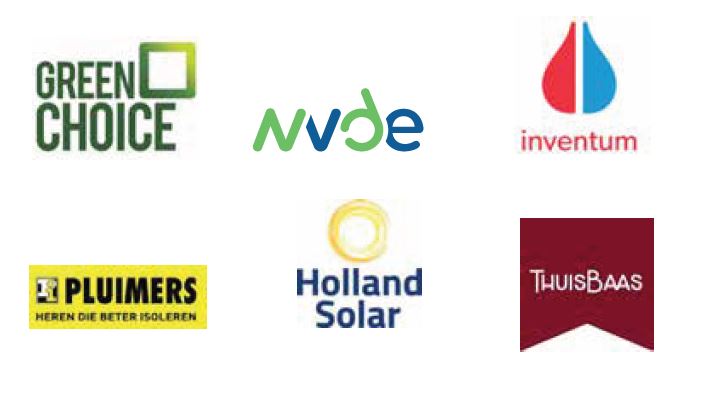
Solution 15 - Extra budget for home insulation - 0.2 Mton
Extra budget for home insulation
Home insulation is a relatively cost-effective way to save CO2 in the built environment. Previous schemes such as the SEEH (subsidy scheme for saving energy in households) were well used and were rapidly “empty”.
Re-opening a scheme such as the SEEH, including a budget of € 100 million for 2019/2020, can lead to more insulation and 0.2 Mtons of extra CO2 savings. Here, too, an extra recruitment campaign would help to actually achieve the intended acceleration.
Important: birds and bats should be taken into account when re-insulating houses. This fact sheet of the Dutch Society for the Protection of Birds shows how insulation can also offer an opportunity for biodiversity.
REDUCTION 2020: 0.2 MTON
REDUCTION 2021: 0.4 MTON
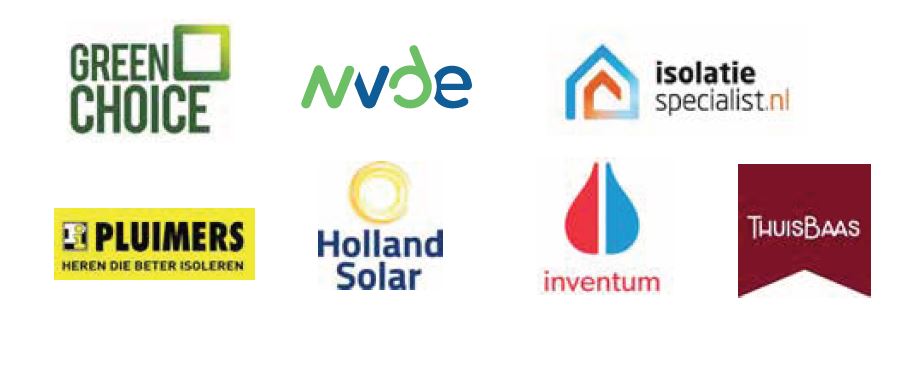
Solution 16 - Stimulate collective solar systems - 0.1 Mton
Stimulate collective solar systems
Housing corporations, private landlords and owners associations would also like to install solar panels on their roofs. However, this is often too complicated for them with the current regulations such as the so-called “postcoderoosregeling” (zip code scheme). In the EU, too, it has been explicitly stated that citizens in multi-storey buildings should have the same access to solar energy as people in ground-connected houses (‘winter package’).
For both these reasons, and in order to accelerate the reduction of CO2 emissions, it would be a good idea to accelerate the use of solar energy on collective roofs by means of a temporary return subsidy of € 0.10 per kWh for a period of two years. The ‘contracting party’ is the housing corporation, landlord or owners association. They can distribute the income fairly among the occupants and settle (part of) the costs via the service costs and/or the rent.
Until the end of 2020, this measure could lead to 250 MWp of extra installed capacity and in 2020 an extra CO2 reduction of at least 0.05 Mtons compared to 1990.
REDUCTION 2020: 0.1 MTON
REDUCTION 2021: 0.1 MTON

Solution 17 - Lease contracts for solar panels on a kWh basis - 0.1 Mton
Lease contracts for solar panels on a kWh basis
Owners of large roofs often do not want to buy and maintain installations with solar panels themselves, but do want to be ‘taken care of’ by another party who places the panels on their roof and then leases them to the person who owns the roof. Currently, these lease contracts cannot be closed on the basis of the generated kWh, but have to be based on a fixed value per year. This is due to the fact that the Environmental Tax Act states that no energy tax has to be paid if the power generation takes place on the roof “at the end user’s own expense and risk”. In the case of a lease construction, the lease company has (part of) the account and risk and therefore it is not allowed to settle per kWh. This creates risks for developers, as a result of which many larger projects never go ahead.
If lease contracts for solar panels can be drawn up on a KWh basis and the requirement ‘for own account and risk’ is abandoned in the Environmental Taxes (Implementation) Act (or via temporary policy rules), lease contracts become fairer, cheaper and more transparent.
Until the end of 2020, this measure could lead to an additional 500 MWp of installed capacity and in 2020 an additional CO2 reduction of at least 0.1 Mtons compared to 1990.
REDUCTION 2020: 0.1 MTON
REDUCTION 2021: 0.1 MTON

Solution 18 - Always count solar panels in energy labels - 0.1 Mton
Always count solar panels in energy labels
If a roof is used for a solar project by a party other than the building owner (e.g. by leasing to a ‘postcoderoos’ project), the PV system does not count towards the building’s energy label. This makes building owners reluctant to make roof space available: they would rather develop their own project on it at a later stage. On balance, this causes delays.
If the solar panels on a roof can always count towards its energy label, regardless of who installed them on that roof, this could lead to an extra 500 MWp of installed capacity until the end of 2020 and an extra CO2 reduction of at least 0.1 Mtons in 2020 compared to 1990.
REDUCTION 2020: 0.1 MTON
REDUCTION 2021: 0.1 MTON

Solution 19 - Continue the combined programme for solar panels and asbestos removal - 0 Mton
Continue the combined programme for solar panels and asbestos removal
The government wants all asbestos roofs to be removed by 2024, but the Senate has not passed legislation to regulate this. The year 2024 was deemed too soon. Perhaps the Cabinet can try to make it attractive for Dutch people to remove asbestos from their roofs by another means, by rolling out provincial schemes such as ‘Asbestos off, sun on’ nationwide.
A new subsidy budget for the removal of asbestos roofs with an incentive to replace them with solar panels could accelerate the process on both sides. This could be done, for example, by extending the SDE+ subsidy with this option. It is expected that this will result in much more solar energy mainly on stable roofs.
Unfortunately, this arrangement had not yet been included in the SDE+ round of autumn 2019. The target saving of 0.1 Mtons has therefore been adjusted to 0 for 2020. Rapid implementation of this scheme is expected to lead to an additional 500 MWp of installed capacity by the end of 2021 and an additional CO2 reduction of at least 0.1 Mtons compared to 1990.
REDUCTION 2020: 0 MTON
REDUCTION 2021: 0.1 MTON

Solution 20 - Solar panels on government buildings - 0.1 Mton
Solar panels on government buildings
The government – national, regional and local – has many roofs that have not been equipped with solar panels and/or green roofs. Setting a good example is wise, especially if you require a lot of action from your citizens.
Many roofs of public buildings offer a good opportunity for solar projects: governments can do it themselves or make the roofs available to local energy cooperations. A government that takes the energy transition seriously, can naturally decide to fill all its suitable roofs with solar panels within the next 1.5 years.
These PV projects can of course use the various available subsidies, but that should not be a prerequisite to get started. In 2020, this additional installed capacity can lead to an additional reduction in CO2 emissions of at least 0.1 Mtons compared to 1990.
REDUCTION 2020: 0.1 MTON
REDUCTION 2021: 0.2 MTON

Solution 21 - Spare transformers for sun & wind - 0.4 Mton
Spare transformers for sun & wind
By using spare transformers (thus releasing the n-1 redundancy requirement), solar and wind projects can be connected to the grid sooner, precisely where grid reinforcement seems necessary now. In extreme cases, solar or wind projects can be disconnected momentarily.
The security of supply for third parties shall not be compromised. We are pleased to mention that this measure, dating from June 2019, will be implemented.
Regulations demanded that there was a great deal of overcapacity in the electricity grid, so that there would never be a moment when there was no electricity at all. In the jargon: there was the standard requirement of n-1 or even n-2 redundancy when connecting renewable projects. For many wind and solar projects a grid availability of 99.99% is not crucial; 99% or n-0 would also suffice.
Rapid adaptation of this requirement in the regulations would directly lead to increased implementation rate of available new solar and wind projects. This is expected until mid-2020 to give 3 GWp of additional connecting opportunities.
Now that the redundancy requirement has been relaxed to n-0 in the north, 80% of TenneT’s reinforcement projects are unnecessary and many sustainable energy projects no longer have to wait. This relaxation could also be temporary.
The rapid adjustment of this requirement in the regulations will immediately result in a higher realisation speed and degree of new and existing and solar and wind projects. This is expected to result in up to 3 GWp of additional connection opportunities up to mid-2020.
REDUCTION 2020: 0.4 MTON
REDUCTION 2021: 0.4 MTON


Solution 22 - Double the downsizing of the pig farming sector - 0.3 Mton
Double the downsizing of the pig farming sector
The government is allocating 120 million euros to help pig farmers close their businesses between now and 2023. According to the PBL, this scheme will lead to a 5% shrinkage of the pig farming sector and a 0.15 Mton CO2 reduction. Double the budget and additional measures could save at least 0.3 CO2 Mtons before the end of 2020.
For example, the government can achieve a substantial decrease of the pig population by helping farmers who have no successor (62%) to close their business prematurely.
Downsizing the sector seems inevitable due to the negative impact on climate, environment, animal welfare, deforestation and human health. According to forecasts, 70% of all pig farmers will stop between now and 2030.
At the same time, it is expected that the number of pigs will decrease by only 10% by 2030. The remaining farms are expected to be many times larger than they are at present. In line with the government’s vision for circular agriculture and in the context of the nitrogen deposition, it is wise to reduce the number of pigs, as the number of farmers also reduces. This would amount to 7 to 8 million fewer pigs and more than 1.5 Mtons of CO2 savings in 2030.
REDUCTION 2020: 0.3 MTON
REDUCTION 2021: 0.4 MTON
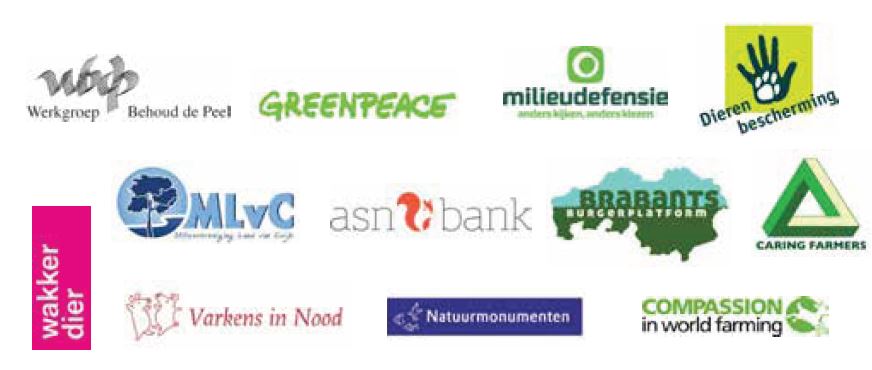
Solution 23 - School roof revolution - 0.2 Mton
Solar panels on schools
Solar panels on school buildings reduce CO2 emissions, and are often a stepping stone to adopting more sustainable measures at school. Combined with sustainability education for children, this contributes to a new conscious generation. That’s the basic idea behind this measure.
The ‘green awareness’ jumps from children to parents and to the neighbourhood around the school. With this measure we asked for a personal letter from Prime Minister Rutte to all 1,260 school boards and to all municipalities asking them to install solar panels on their roofs and save energy. This letter was sent in October 2019 on behalf of Minister Ollongren. Thanks to this letter a great deal has been set in motion. In addition, with this measure we ask that the efforts to make schools more sustainable be included in all Regional Energy Strategies.
The calculation: 0.1 Mton CO2 savings by the end of 2020
- If 20% of all those unused roofs are fitted with solar panels in 2019 and 2020, more than 400,000 panels will be installed on 1,250 school buildings. These will save 74,000 tonnes of CO2 per year.
- By installing LED lighting in half of those 1,250 schools, we will save another 6,000 tonnes of CO2 per year.
- Furthermore, it is expected that at least 150 schools will take further measures, such as more efficient use of space and insulation. This will result in 10,000 tonnes of CO2 reduction.
- In addition, the energy management of 750 relatively new school buildings can be significantly improved. Savings: 11,000 tonnes of CO2 per year.
Schools Energy Savings Loan
Solar panels, insulation, LED lighting and monitoring systems require a start-up investment. Although these investments are recouped, not every school board has the room to invest. For those schools, there is the Schools Energy Savings Loan, a loan at a competitive interest rate. The Ministry of the Interior and Kingdom Relations and Rabobank have made € 5 million available.
REDUCTION 2020: 0.1 MTON
REDUCTION 2021: 0.1 MTON
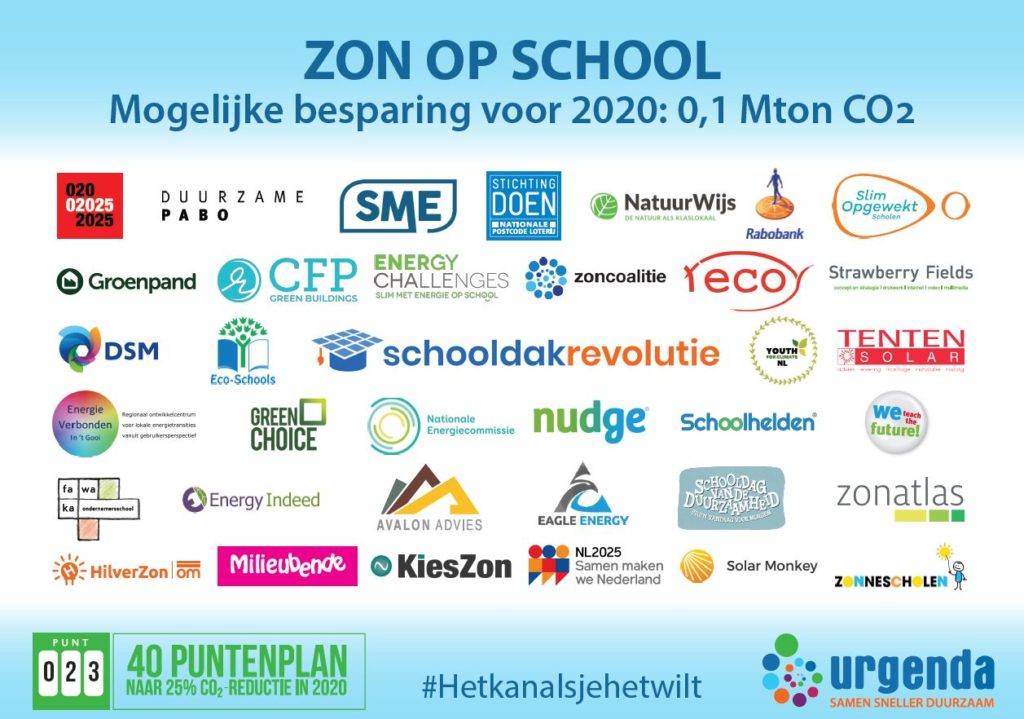
Solution 24 - LED lighting in companies and greenhouses - 0.8 Mton
LED lighting in companies and greenhouses
The House of Representatives passed a motion by a large majority to oblige companies to use LED lighting only by 1 July 2020 at the latest. By accelerating the implementation of this motion and making LED lighting mandatory as of January 1, the government can save 0.9 Mton CO2 by the end of 2020.
Help in the form of a loan for greenhouse farmers who want to switch to LED, will lead to an additional 0.1 Mton CO2 emission reduction. The purchase of LED lighting pays for itself through a lower energy bill and can therefore count on broad support.
Loan for greenhouse farmers
Greenhouse farmers replace their lighting approximately every 7 years, about 15% of them will do so in the coming year. LED lamps now cost about three times more than traditional lighting. For a horticulturist, that’s quite a hurdle to take. The government can help by making a loan available for an investment in LED lighting. If 10% of the greenhouse farmers do this, it saves more than 0.1 Mtons of CO2 per year. If all horticulturists do this, it will save more than 1.0 Mton of CO2.
REDUCTION 2020: 0.8 MTON
REDUCTION 2021: 1 MTON
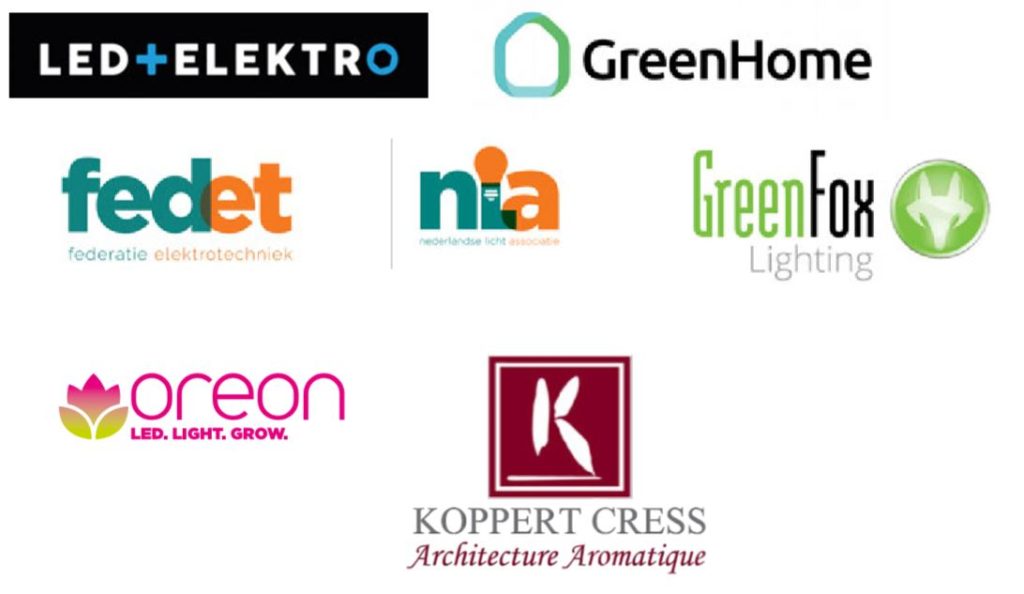
Solution 25 - Travel differently - 0.7 Mton
Travel differently
The CO2 emissions in the Netherlands from commuter and business traffic by car amount to no less than 8.8 Mtons (2016). Dozens of large companies with almost 300,000 employees have united in the coalition ‘Commute Differently’ (Anders Reizen). They want to stimulate more sustainable travel and thereby reduce their CO2 emissions, among other things. In a report dated March 2018, CE Delft quantified the effects of various measures on emissions. A number of these measures could still lead to substantial emissions reductions in 2019 and 2020. In the longer term, the following three measures would lead to an almost 3 Mtons CO2 emission reduction. In the short term of one year 0.7 Mton should be possible.
a. Behavioral campaigns
The choice for sustainable transport can best be promoted by a targeted campaign from the employer and becomes more successful when it is combined with a competitive element and offering of material and other rewards by employers.
Research has shown that the additional effect of behavioural campaigns results in a permanent reduction of up to 23% of home-work kilometres. When such a campaign is actively supported by employers and repeated annually, a great effect is to be expected. If the government were to encourage and support this type of programme with a contribution over the next two years, a CO2 reduction of 10 to 20% could be achieved in both the short and slightly longer term.
b. Reduced allowance for car use, for everyone
If the maximum un-taxed commuting allowance for the car is adjusted downwards from € 0.19 per km to € 0.10 per km, according to CE Delft this leads to less car traffic, and hence fewer emissions of nitrogen oxide and particulate matter and less traffic noise. It also reduces traffic jams and increases the number of people using public transport. They will use travel time more as working time.
The actual, average costs per car kilometre are € 0.49 (ANWB, 2019). With an allowance of € 0.19, 39% will therefore be paid by the employer; with a reduction to € 0.10, this will drop to 20%. This leads to a reduction in car kilometres of 9.6%.
c. Reimbursement for bicycle kilometres of 0.19/km
Replacing the kilometric allowance for commuting by car for a € 0.19 allowance per cycled kilometre for anyone living within cycling distance (less than 15 km) will lead to an considerble increase in bicycle use. The kilometre allowance for the bicycle may be granted un-taxed by the employer.
Research shows that 56% of motorists are seriously considering switching to cycling and 58% of them indicate that a kilometric allowance would be an important incentive for switching. This would lead to a 32% reduction of car use on journeys up to 15 km. Because the measure only has an effect for short distances (13% of car kilometres) the total effect amounts to 4%.
For measure b, the government would have to reduce the maximum allowance. For measure c only an information campaign and possibly a Green Deal would be needed.
REDUCTION 2020: 0.7 MTON
REDUCTION 2021: 1 MTON
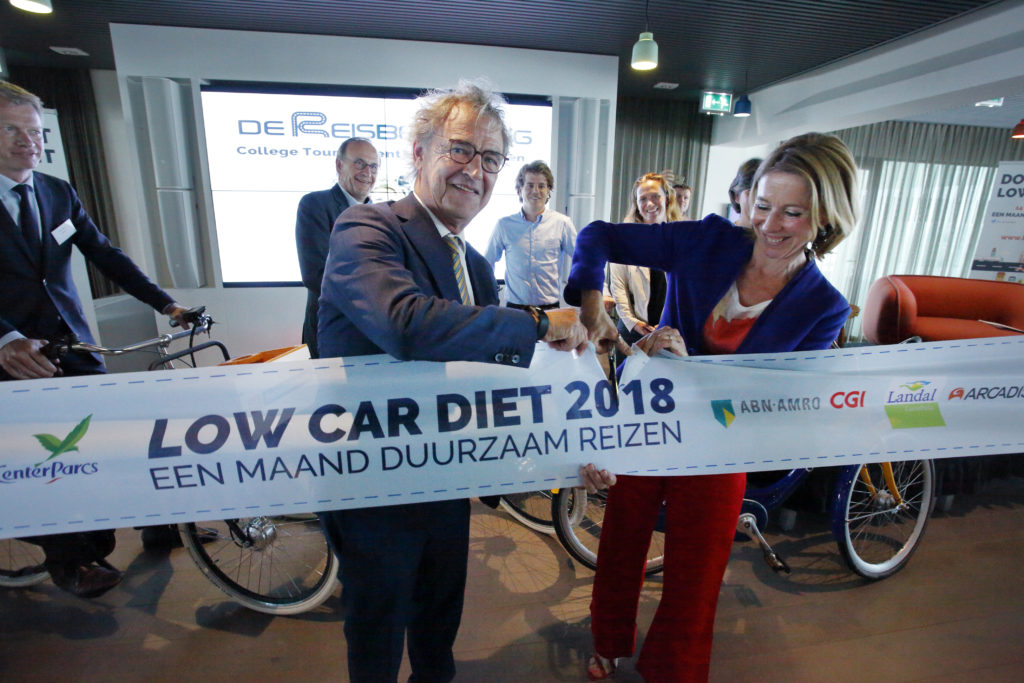

Solution 26 - Adjusting heat installations in companies - 0.5 Mton
Adjusting heat installations in companies
For the proper functioning of a climate control system, it is important that the air volumes in the installation are aligned with the design values. In addition, good hydronic balancing is very important in all kinds of heating installations in order for them to work efficiently. Poorly balanced systems use too much energy and cause unnecessary CO2 emissions.
The ‘Activities Decree on Environmental Management’ (activiteitenbesluit milieubeheer) obliges companies and institutions that consume 50,000 kWh of electricity or 25,000 m³ of natural gas (equivalent) or more per year to implement all energy-saving measures with a payback period of 5 years or less. This is the ‘energy saving obligation’ (energiebesparingsplicht).
Companies can meet this energy saving obligation in various ways, for example by taking all suitable measures listed on the Recognised Energy Saving Measures Lists (EML). These lists contain energy saving measures for 19 sectors with a payback period of 5 years or less (see RVO.nl).
The Building Decree (het bouwbesluit) states that a properly balanced installation can save 23% on gas consumption. Logically, hydronic balancing of installations was to be included as a recognised measure in January 2020. Unfortunately, at the last minute the Cabinet allowed itself to be sidetracked by a single report containing many incorrect assumptions. The counter-reaction by Techiek Nederland was of no avail and a lot of time was lost.
Urgenda once again calls for hydronic balancing to be added to the list of recognized measures as soon as possible.
The technical potential for non-residential construction lies between 20 and 30 Petajoules. In June 2019, Urgenda wrote: “For the next 1.5 years, the savings could amount to 12 to 16 Petajoules. Rounded down this leads to 0.5 Mton CO2 reduction”. Now this has to be done in 1 year, so an enormous acceleration is necessary.
REDUCTION 2020: 0.5 MTON
REDUCTION 2021: 0.5 MTON
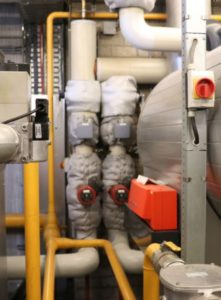


Solution 27 - Proper tyre pressure - 0.1 Mton
Proper tyre pressure
60% of all cars drive with under-inflated tyres. This is because tyres slowly lose pressure (2 to 3% per month) and therefore need to be inflated regularly. Place 2,500 Smart Tyre Pumps in smart places and offer their use free of charge. If 50% of motorists use them, we save 0.2 Mtons of CO2 per year.
Most people inflate their car tyres at filling stations. Unfortunately, research shows that these pumps are not user-friendly: 70% to as many as 90% of all motorists leave the pump with an insufficient tyre pressure. In fact, more than 35% of motorists (unknowingly and unintentionally) even drive away with a lower tyre pressure.
As the government itself points out, there is a lot to be gained from keeping tyres inflated. Stientje van Veldhoven, Minister for the Environment and Housing, has said: “If all cars were to drive around with the right tyre pressure, we would save about 0.4 Mtons of CO2 per year in emissions”.
If half of all motorists inflate their tyres correctly every two months, this saves 0.2 Mtons of CO2 per year. It also saves €100 per year per car (or a total of €400 million!). Most people are unaware of the €100 savings that can be made by inflating their tyres for 10 seconds every now and then.
So better communication about this is important and it’s good that the recent government campaign ‘Everyone Does Something’ (Iedereen Doet Wat) devotes attention to tyre pressure. Proposal: place signs over the road saying “Inflate your tires 4 times a year and you’ll save €100.
REDUCTION 2020: 0.2 MTON
REDUCTION 2021: 0.2 MTON
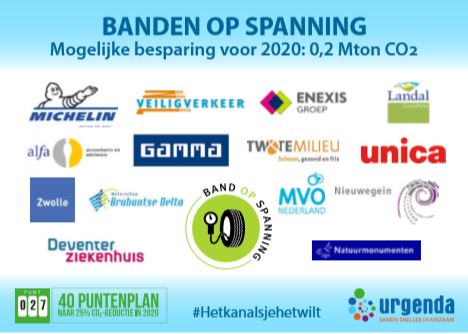
Solution 28 - CO2 Performance Ladder - 0.8 Mton
CO2 Performance Ladder
With this measure, we propose that medium to large-sized companies, organisations and governments should introduce a professional CO2 management system, like the CO2 Performance Ladder, in 2020. This can save 1.0 Mtons of CO2 emissions. According to a first estimation of the results of the proposed measure, even 2.0 Mtons of CO2 can be saved, that is twice as much.
The CO2 Performance Ladder is an instrument that helps organizations reduce carbon emissions in their organization, in projects and in the business sector. The instrument is used both as a CO2 management system as well as a procurement tool. With a certificate on the Ladder, organizations can receive an award advantage for their registration on tenders. An increasing number of companies and organisations – including municipalities and ministries – are also opting for this because they want to pursue a credible and independently monitored climate policy. The request for the government is to formalise the proposal by law, just as it did for the mandatory list of measures.
Organizations that obtain a certificate on the Ladder will experience this as an investment that is immediately returned in terms of low energy costs, material savings and innovations. The Ladder’s main objective is to stimulate organizations to gain insights in their CO2 emissions, and to continuously seek opportunities to cut back these emissions in the organization and consequently within projects.
https://www.skao.nl/what-is-the-ladder
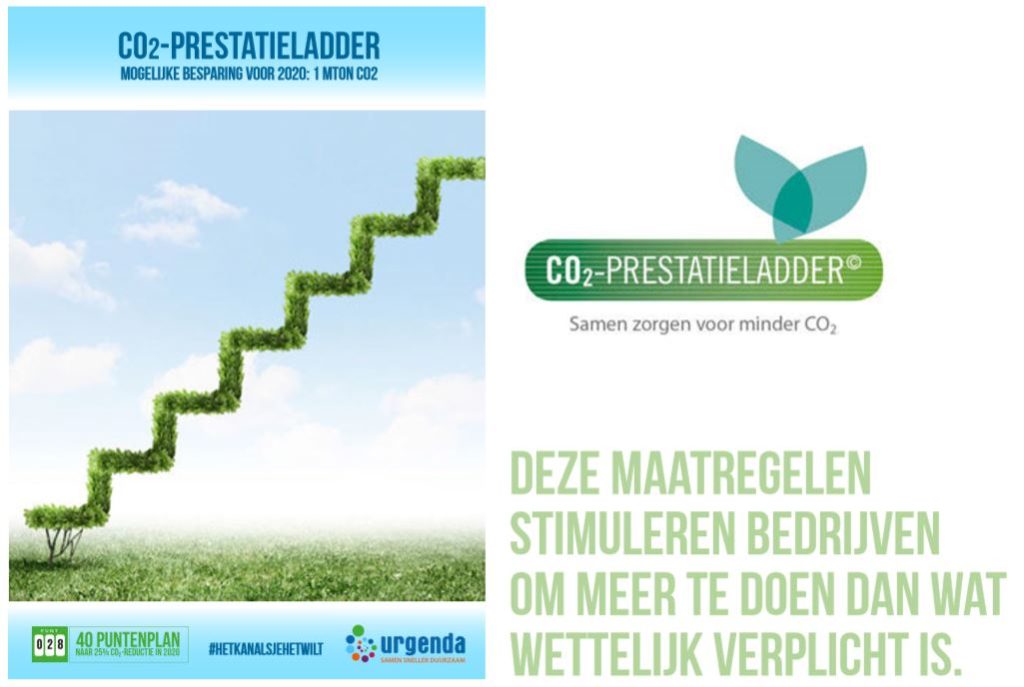
Solution 29 - How low can you go? CV optimization households - 0.4 Mton
How low can you go? CV optimization households
Many central heating boilers and certainly high-efficiency boilers of private individuals can be set to a lower temperature: from 80/90 degrees Celcius to 70 or sometimes as low as 60 degrees Celcius. A high-efficiency boiler will then (better) condensate and its efficiency will be higher. This saves a lot of gas and money, and comfort remains uncompromised. Also, many boilers are not properly hydronically balanced and therefore do not run efficiently. A national campaign to encourage people to have their installation checked in this respect and to train technicians to do this properly are part of this solution. It is very important to explain the costs people can save through better hydronic balancing. This measure pays for itself quickly.
The technical savings potential in the entire housing stock is somewhere between 30 and 35 Petajoules. For the coming year, a reduction of 0.4 Mtons would be achievable if 1/3 of the people with a central heating boiler lowered the temperature on it or had it adjusted.
REDUCTION 2020: 0.4 MTON
REDUCTION 2021: 0.8 MTON
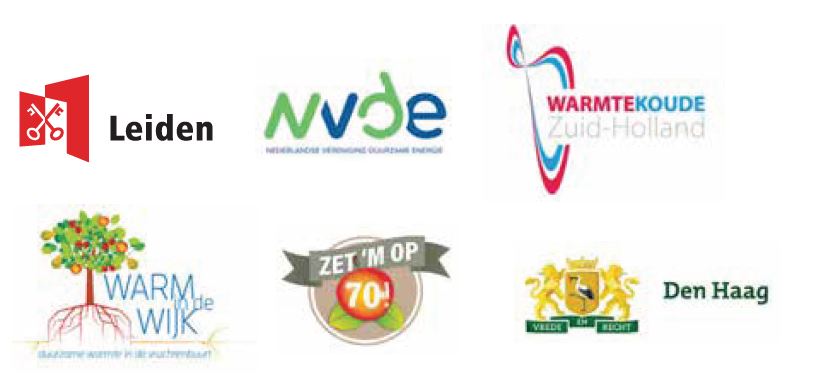
Solution 30 - MOT for buildings - 0.1 Mton
MOT for buildings
Periodic monitoring of the actual energy performance of buildings, a kind of MOT test or Energy Performance Assessment (EPK), could yield savings in the order of 0.1 to 0.2 Mtons (5 to 8 Petajoules) over the next 12 to 18 months. An EPK can be implemented quickly and easily, without changing legislation. The EPK would cover all establishments under the ‘Activities Decree 2.15 regime’ and/or all buildings with a usable space of more than 500 m2.
An EPK is needed to fill a gap in current policy that focuses on the theoretical average performance of individual energy saving measures, which rarely show this performance in practice. There is a big gap between the theory of, for example, the energy label and the actual energy performance in practice. This problem also occurs with the ‘Sectoral Approved Energy Conservation Measures’, where checklists are used to check whether the owner or entrepreneur has the ‘right’ installation in the building, but not to check whether the installation is maintained, properly adjusted and actually delivers the intended result. For decades, all reports in the real estate sector have shown that over 80% of the real estate does not perform as intended. This low-hanging fruit can be picked quickly and yields considerable climate gains.
REDUCTION 2020: 0.1 MTON
REDUCTION 2021: 0.1 MTON

Solution 31 - City tax for a livable city - 0 Mton
City tax for a livable city
In order to make the city of London livable again within the city ring, the Congestion Charge was introduced in 2003. This is still one of the largest areas in the world with such a system. The Congestion Charge is a toll system whereby cars in the central area within the ring – the Congestion Charge Zone – have to pay 10-12 pounds per day between 7 a.m. and 6 p.m.
The toll is charged via a license plate recognition system. Electric and very clean vehicles pay less than polluting diesel cars and buses. This has been further refined and since 2015 only fully electric vehicles are exempted. Now car sharing will be encouraged too. In the first ten years, this system generated a net income of 1.3 billion euros, which was invested in public transport, improvements to roads and bridges, and solutions for pedestrians and cyclists. The largest amount was invested in improving the bus network (£960 million). The toll system resulted in 10% less congestion and 11% fewer car kilometres.
According to the Amsterdam Climate Neutral Route 2050 (January 2019), emissions from transport are 0.36 Mton per year. A test within the ring of five major cities (with a scan on all exits) should be possible with financial support from the government. Five Dutch cities that together have a conservative estimated 1.5 Mtons in transport emissions. Suppose that the car kilometers, just like in London, decrease by 11%, then – very conservatively – it should be possible to reduce 0.1 Mtons of CO2. Because we’re now well into 2020, the reduction potential for 2020 has been set at 0.0 Mtons. For 2021, a 0.2 Mton reduction or more is certainly feasible.
REDUCTION 2020: 0 MTON
REDUCTION 2021: 0.2 MTON
Solution 32 - Innovative Chemical Recycling Techniques - 0.1 Mton
Innovative Chemical Recycling Techniques
In the short term, chemical recycling could be a good addition to mechanical recycling for plastic waste. In both the new Coalition Agreement and in the transition agendas for the circular economy, chemical recycling is seen as an important solution for making the plastics chain more sustainable.
On behalf of the Ministry of Economic Affairs, CE Delft has calculated that by 2020 a reduction of 0.2 Mtons will already possible.
The government can make this technique possible by:
- including monomer chemical recycling in the plastic recycling targets on a one-to-one basis;
- counting feedstock chemical recycling by a factor of around 50% in the targets for plastic recycling;
- facilitating investments in chemical recycling under the new SDE++ subsidy scheme;
- increasing the targets for plastic recycling, including in the packaging framework agreement;
- giving chemical recycling a better position in the National Waste Management Plan (LAP3) in terms of the quality of recycling.
REDUCTION 2020: 0.1 MTON
REDUCTION 2021: 0.2 MTON
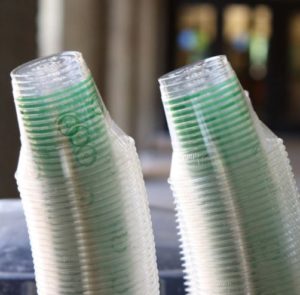
Solution 33 - Doubling the bottom up power of energy cooperatives - 0.1 Mton
Doubling the bottom up power of energy cooperatives
The government can easily double the CO2 savings by bottom up movements by facilitating the cooperatives with the right instruments. Most important in the short term is the tariff used by the ‘postcoderoosprojecten’ (local cooperative green energy projects).
Strengthen the ‘postcoderoos’ scheme and double renewable energy projects
The government has developed the Reduced Tariff Scheme (RVT) (postcoderoosregeling) as an instrument for energy cooperatives to help realise (local) renewable energy projects. This tax scheme is based on the supply of energy, without charging an energy tax, and the related VAT to members of the cooperative. It is a nice and successful instrument to help citizens benefit from the energy transition and motivate them for it.
Due to the discussion about changes to the tax rate on energy, the cooperatives and the financiers are questioning the feasibility of projects. The hundreds of energy cooperatives in the Netherlands are therefore asking the government to convert the RVT into a feed-in fee that is no longer variable, but is fixed at € 0.12 per kWh for a longer period of time. This makes the funding more predictable and will increase the appeal enormously.
In 2019, the amount of installed solar power capacity will again grow by more than 50% to 2408 MWp. Corporations expect an additional growth of 250 MWp if there is a fixed fee for the postcoderoos projects, leading to an extra 0.1 Mton CO2 emission reduction in 2020. For the longer term, continuous growth from the bottom up can be supported by two measures.
1. Expanding funds from which energy cooperatives can borrow money for the first phase of sustainable energy projects.
Larger projects such as solar farms and wind turbines require major investments. For cooperatives, financing the exploitation phase is often not a problem, but financing the development phase is. In that phase, they have to apply for an environmental permit, carry out numerous studies and need sound project management. These costs quickly amount to 5 to 10% of the total cost of a project. Money that cooperatives do not generally own and that most financiers do not want to finance, meaning that the cooperatives have to resort to large commercial parties or investors who will subsequently claim a significant part of the proceeds. A large fund from the government can be of considerable help in this respect.
2. Encourage municipalities to introduce ‘green fees’
Currently, each municipality has its own regime for fees for sustainable projects. There are municipalities that charge little or nothing (e.g. only on the substructure of solar installations) where others use the full installation price as a basis for the calculation of the fees. In some cases, this means a cost increase of up to 3%. Moreover, cooperatives often have to pay these fees regardless of whether projects do or do not proceed. This can leave a cooperative with tons of debt, but without revenue.
It would help if VNG (The Association of Netherlands Municipalities) were to draw up a model ordinance shortly to encourage municipalities to switch to green fees.
Proposal:
- In the case of solar parks, only include the structure in the calculation of the construction costs and use a fixed percentage (2.5%);
- If the project does not proceed, only charge a fixed, minimum fee of € 2,500;
- Calculate a fixed percentage based on the construction costs (0.5%) for wind turbines.
This measure has been endorsed by more than 200 Energy Cooperatives.
REDUCTION 2020: 0.1 MTON
REDUCTION 2021: 0.1 MTON
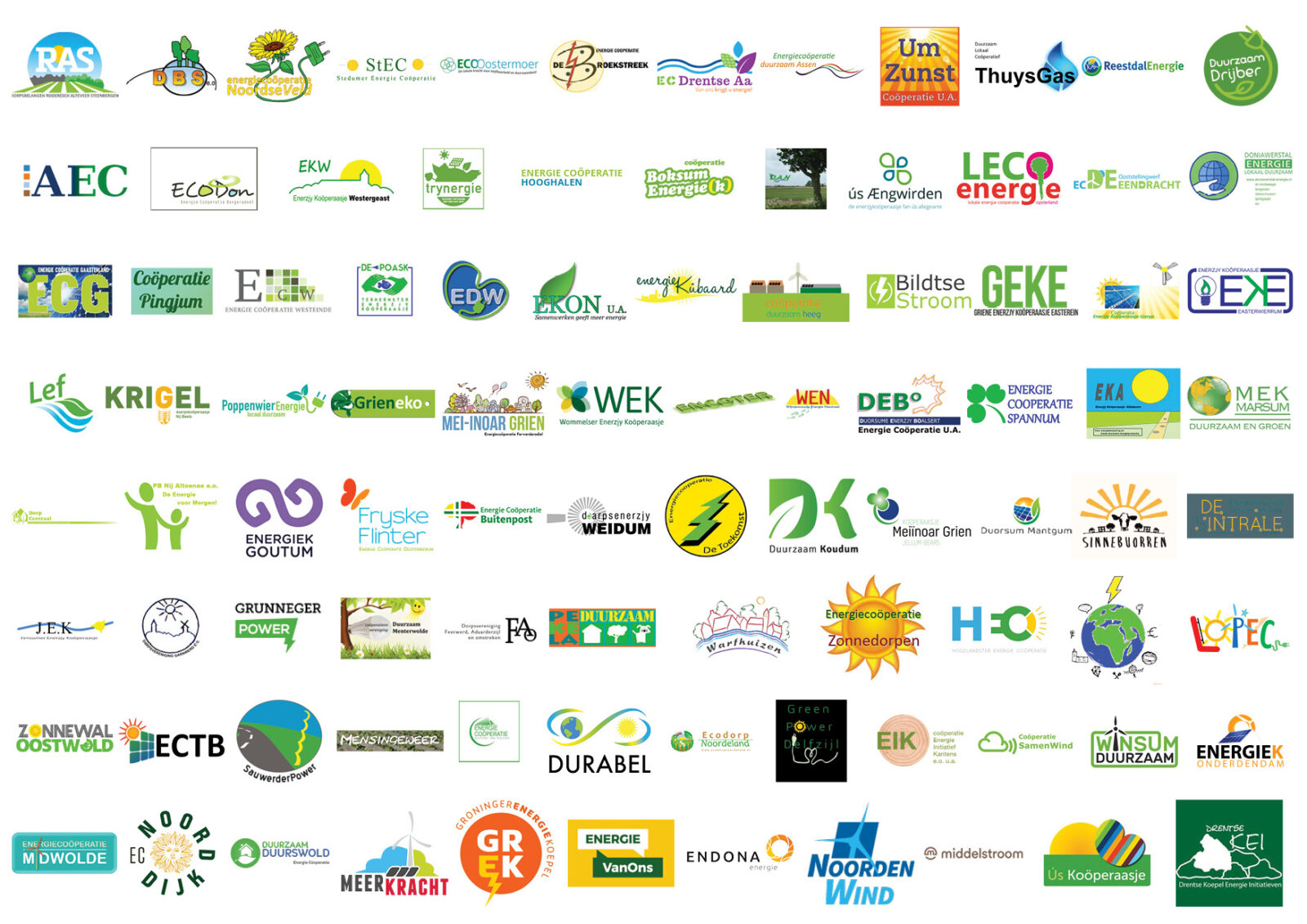
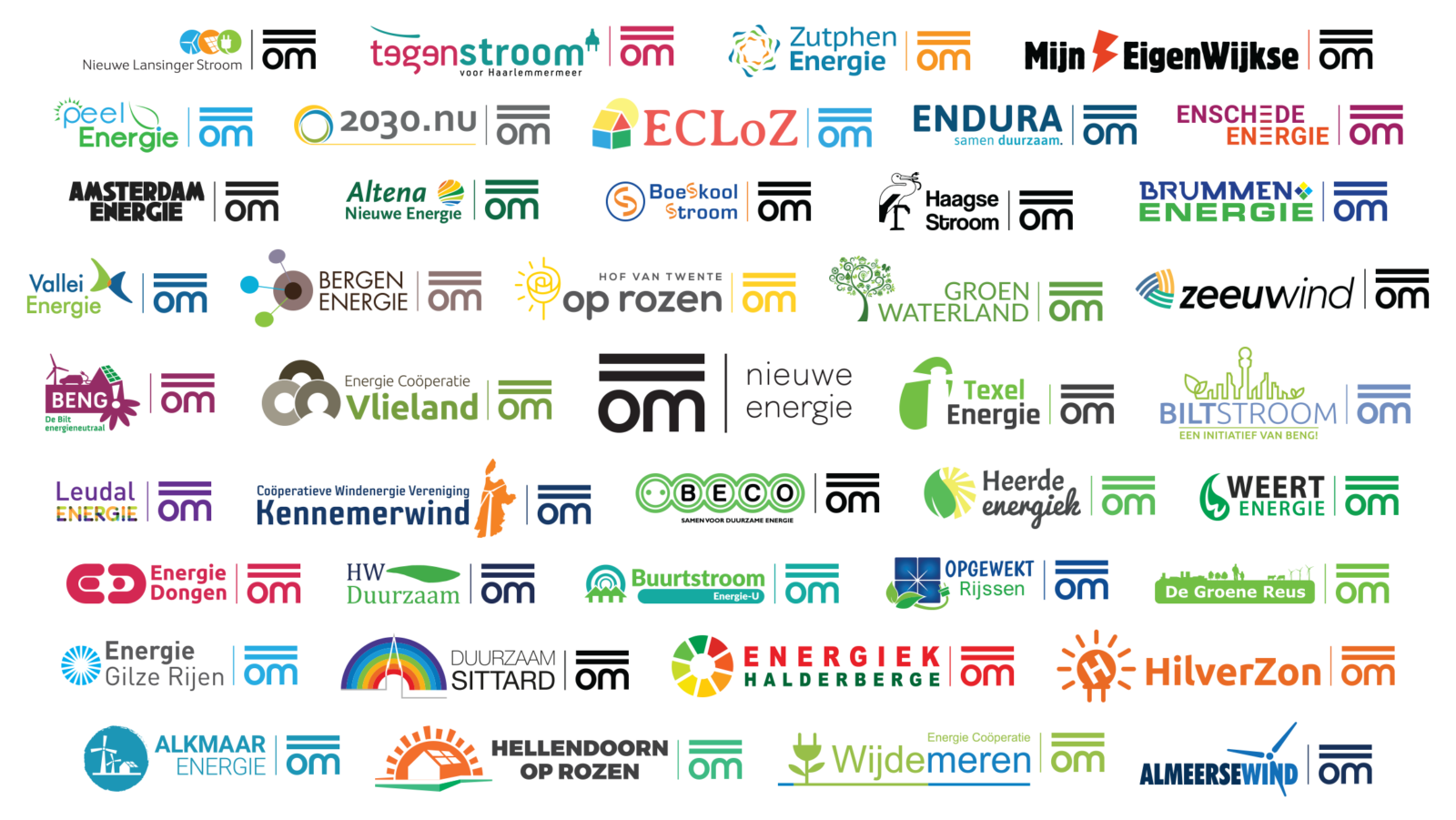
Solution 34 - Action plan from single to HR++ glass - 0.2 Mton
Action plan from single to HR++ glass
In the Netherlands, more than 1 million homes have single glass, an average of 20 m2 per home. Replacing this with HR ++ glass costs almost 3,200 euros. That is a major investment for citizens, but they will save 460 euros a year in energy costs, so the payback period is 7 years. With a special ISDE subsidy for replacing single glass over the next 1.5 years, 250,000 households could be tempted to make the move.
Solution 34 proposes to offer 1,000 euros per household through an ISDE subsidy, so that the payback period becomes around 5 years.
On average, the savings from replacing single glazing with HR ++ glass, would be 800 kilos of CO2 per year (source: MilieuCentraal) per house. With 250,000 households, that means a profit of 0.2 Mtons.
REDUCTION 2020: 0.2 MTON
REDUCTION 2021: 0.3 MTON

Solution 35 - Forests, trees and verges - 0.1 Mton
Forests, trees and verges
While the industry is looking for modern techniques to capture CO2, the very best and cheapest technique has already been discovered: trees. Forests, in particular, capture a lot of CO2 in the soil and in the trees themselves. But individual trees also absorb CO2, provide cooling and help with water storage. More trees and more greenery have therefore already been included in the Climate Agreement. Solution 35 is threefold: speeding up the plans for more forests, more trees, and better use of verges. This solution complements solution 7: sustainable forest management of existing forests.
Acceleration for more woodland
By 2027, the government wants to have 80,000 more hectares of woodland in the Netherlands. Ultimately this should lead to 0.5 Mtons of extra CO2 absorption per year. The sooner this starts, the greater the profit will be in 2030. After all, when trees are about 10 to 30 years old, they absorb the most and the forest floor also begins to develop a healthy layer of humus in which about a third of all of the forest’s carbon is stored. Eventually a forest becomes mature and will have reached its maximum uptake, but it will also be able to retain this carbon for thousands of years.
Not all places in the Netherlands are suitable for new forests. Planting trees in or near meadows, for example, is not conducive for meadow birds. In other places, we would rather have heathlands than woodlands, and having solar panels on roofs shaded by trees is not desirable either. However, there is still enough space left, in which more than one goal can be served. For example, a production or food forest makes a very attractive buffer around protected nature reserves. And forests along the roads and highways capture fine dust and provide sound insulation. Forests around residential areas provide space for recreation, provide cooling and clean air and spare nature areas.
CE Delft has carried out a preliminary study to identify an area of 100,000 hectares that could potentially become woodland: there is great potential for this along motorways and around resting areas along motorways. These are excellent places for the government to fast-track and realise 20% of the forest plan in the 2019/2020 planting season. The investment is considerable, but the costs are recouped, according to CE Delft.
Reintroduction of coppice along roads
The Netherlands has 8,000 km of N-roads, with great potential for trees. With this measure we propose first of all to stop felling trees ‘for safety’ and to let go of the (outdated) 4.5-metre CROW guideline in places where this is possible. We also propose to use the public space along N-roads to store CO2 in fast-growing, i.e. living coppice and pollarded trees, and to ensure a constant supply of biomass with a very short CO2 cycle. This can be done in the form of hedgerows, rebate forests or plantations.
Acceleration towards a greener countryside
Over the past decades, biodiversity has declined dramatically as landscape elements such as hedgerows and hedges disappeared and roadsides became more barren. Municipalities, water boards and other land management organisations allowed farmers to mow parts of their grounds and use them administratively for manure accounting. In practice, more than 1% of agricultural land was wrongly included in the manure accounts.
It is time to turn the tide. The municipality of Berkelland has already started with this. In consultation with farmers, the municipality is having the wrongfully removed landscape elements reinstated. They are also taking back control of the verges and planting trees and flower borders. This results in CO2 savings and with adequate enforcement this leads to less manure production and fewer animals (1% fewer animals means a 0.18 Mton reduction, here we assume a conservative 0.04 Mtons).
Fortunately, things are already moving in the right direction: according to the agreements in the Climate Agreement, the Association of Netherlands Municipalities (VNG) is urging all municipalities to grow by 1% more trees. Space for these trees can be found in agricultural areas. The ‘Attack plan to strengthen landscape identity through landscape elements’ of the Netherlands Organisation for Agriculture and Horticulture (LTO) in the Climate Agreement promises constructive cooperation with municipalities and other land management organisations in this area. Like the large site management organisations, LTO has also signed the biodiversity restoration plan and they all have an urgent wish to create more nature.
The Government can help by supporting all these organisations with proper monitoring of roadside maintenance fraud and manure fraud using cadastral maps and aerial photographs. There is also an opportunity here, namely to create a new business model for farmers for nature-friendly roadside management and the maintenance of landscape elements.
REDUCTION 2020: 0.1 MTON
REDUCTION 2021: 0.2 MTON

Solution 36 - Stopping recreational use of laughing gas - 0.1 Mton
Accelerated action against recreational use of laughing gas
Nitrous oxide (N2O) is a very strong greenhouse gas: 1 kilo of nitrous oxide has the same effect as a staggering 265 kilos of CO2. Among other things, it is released from soil that has been fertilized with artificial fertilizer or animal manure. It is also used in anaesthetics and as an aid in engines to increase engine power.
In recent years, the recreational use of nitrous oxide as a drug has increased, causing all kinds of problems. Paralysis, polluted streets, car accidents and climate change. Fortunately, in December 2019 the Cabinet already decided that nitrous oxide will fall under the Opium Act, which prohibits recreational use. The sooner that consumption stops, the greater the climate gain. National enforcement is still some way off, but municipalities can get straight down to business by banning the sales of nitrous oxide at events.
The increase in nitrous oxide imports seems to be almost entirely due to ‘recreational use’. That is an extra 500 tonnes of nitrous oxide, which equals 0.1 Mton of CO2-eq emissions. The government can reduce 0.1 Mton emissions year after year if this form of laughing gas use is reduced. Apart from CO2 reduction, there are other benefits: fewer car accidents, fewer health problems and cleaner streets.
REDUCTION 2020: 0.1 MTON
REDUCTION 2021: 0.1 MTON
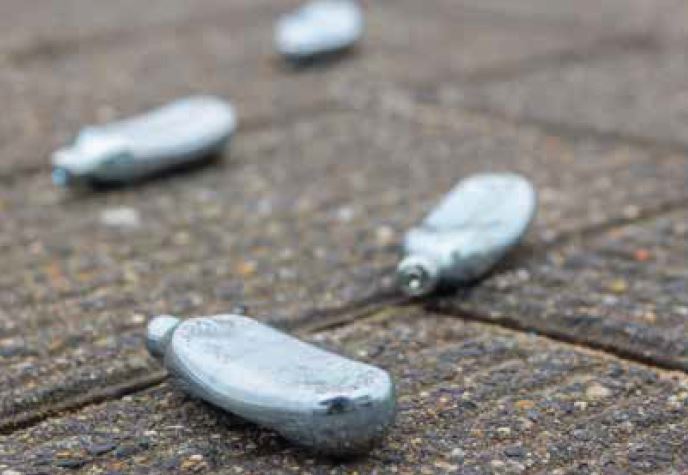
Solution 37 - More sustainable asphalt - 0.1 Mton
More sustainable asphalt
The Netherlands has one of the most densely branched road networks in the world. Of this network, there are around 130,000 kilometers of paved road. The government is the largest ‘client’ in the civil engineering, road and hydraulic engineering sectors, and it can therefore set conditions for more sustainable asphalt in tenders.
Realistically, a reduction of 0.1 Mtons of CO2 will be achieved by 2020 through the construction of cycling paths made of bio-based asphalt, more use of asphalt made at a lower temperature, more reuse of raw materials from old asphalt and measures to extend the life span of asphalt.
REDUCTION 2020: 0.1 MTON
REDUCTION 2021: 0.2 MTON

Solution 38 - More use of olive sand - 0.1 Mton
More use of olive sand
Olivine is a very common mineral on earth (at least a quarter of the earth’s crust). Olivine removes CO2 through natural weathering: it reacts with CO2 and fixes the carbon for a very long time. By grinding it into sand, the natural weathering reaction is accelerated. Taylor et al. (2016) estimate that this method has the potential to reduce the CO2 concentration by 30 to 300 ppm (the current concentration of CO2 is about 415 ppm). The study Drawdown (Paul Hawken, 2018) mentions olivine as a promising climate solution.
The Netherlands is a frontrunner
The Netherlands leads the way in the application of olivine sand. The Dutch company greenSand delivered approximately 10,000 tonnes in 2019. There is every reason to assume that this growth will continue at an accelerated pace in 2020, resulting in the sale of about 40,909 tons of olivine without any additional policy, capturing at least 13,000 tons of CO2 (0.013 Mton).
In 2012, Deltares calculated a number of options for the municipality of Rotterdam and also made these calculations for the whole of the Netherlands (see table, in Dutch).
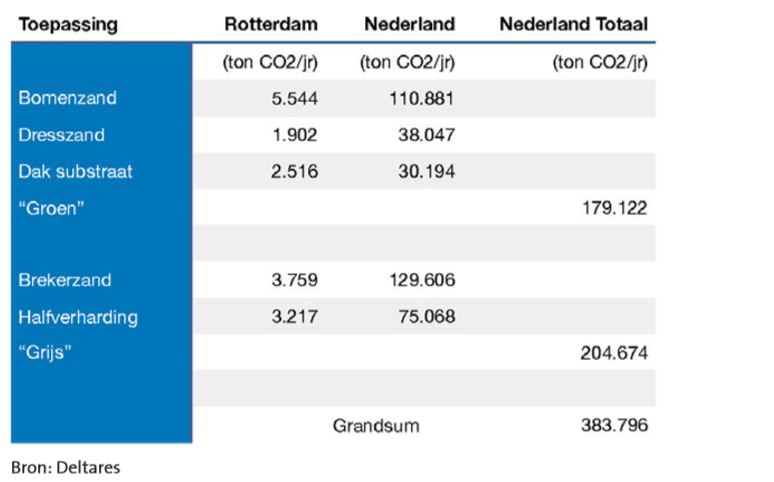
Potential 2020
A quarter of this should be achievable with sufficient policy support, allowing around 100,000 tonnes of CO2 to be captured by olivine sands in 2020. With additional policies, we can expect to capture 0.1 Mtons of CO2.
The costs are subject to inflation: large-scale supply quickly depresses the price. A tonne of olivine sand costs € 19 (depending on grain size) and with that at least 0.33 tonnes of CO2 is captured (in 30 years) . The maximum cost for 2020 is therefore € 5.7 million (100,000 tons x 3 x € 19) or € 57 per ton of CO2. This is quite similar to the costs estimated by the Netherlands Environmental Assessment Agency (PBL) on a pilot scale. When scaling up, the costs fall rapidly: the American Project Vesta, to which Dutch entrepreneurs and scientists make a significant contribution, charges 8.50 dollars per tonne of CO2 stored.
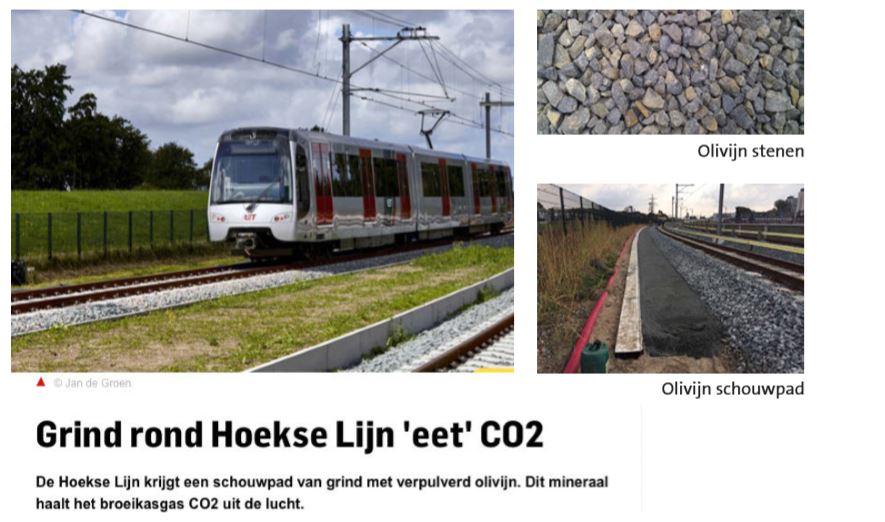
REDUCTION 2020: 0.1 MTON
REDUCTION 2021: 0.1 MTON

Solution 39 - Government campaign ``It can be done`` - 0.2 Mton
Government campaign “It can be done”
In the short term, most can be achieved with energy saving. This can be done in many ways, with households as well as with offices, farmers and industry. The population of the Netherlands has recently come to think that “the energy transition” is a large, stubborn, money-consuming monster that delivers nothing.
We proposed a good multimedia campaign called ‘It can be done’ (Het kan wel), which demonstrates that saving energy or choosing other sustainable solutions is fun, can generate money and leads to an improved quality of life in many areas. The cabinet adopted this with the ‘Everyone does something’ (Iedereen doet wat) campaign. It’s a good start, which can be complemented with the following ideas.
- Surprise Dutch citizens with a free energy-saving giftbox. These boxes could for example include a water-saving shower head, ventilator sets to improve the airflow of existing radiatiors, radiator foil to stick behind the radiators and radiator foil to wrap around the close-in boiler. The boxes can be collected at central points (in collaboration with supermarkets or postal collection points for example).
- Promote the CO2 Open – www.climatecleanup.org. Involve people in the energy transition by providing a facility that invites people to come up with innovative ideas and helping them to scale up.
- Promote the free CO2 Calculator app. A director who is aware of their company’s CO2 emissions and energy-saving opportunities will be more inclined to improve sustainability than a director who has no insight into this.
- Start the E-team. Dedicate funds to set up “E-teams” that pay unexpected visits to companies and point out their legal obligations to save energy. Walk around the company and offer suggestions. Say you’ll be back in six months and expect it to be okay by then, otherwise there will be fines.
These are just four ideas, which can easily be supplemented with other ideas. They show how important an innovative communication scheme and doing something positive for households is. It could save 1 Mton. Because we’ll take a more conservative estimate here of 0.5 Mton, and because it’s already April 2020, we’ll set it at 0.2 Mton.
REDUCTION 2020: 0.2 MTON
REDUCTION 2021: 0.5 MTON
Solution 40 - Innovations with potential - 0.1 Mton
Innovations with potential
There are many innovations that could be scaled up quickly. In the short term of 1 year the effect on CO2 reduction is still relatively small, but for the 2030 goal they can make a much larger contribution. In order to speed up the transition, it would help if those innovations could reach maturity more quickly.
We mention a number of them here, which together will even lead to 0.1 Mton before the end of 2020, but certainly have a lot of potential after that.
- More sustainable paper
- paper process without water
- additional energy savings in transition phase
- Q-roof on monumental buildings
- Wiras, the more efficient railway switch
- Building with hemp
- Stimulating geothermal energy
1. Breakthrough in the paper industry
The paper industry in the Netherlands uses a lot of natural gas to heat water, emitting 1 Mton of CO2 annually. The industry is working on many solutions, such as making paper without water. Until this new production process can be used on a large scale, there are interim solutions to reduce emissions in the short term. In 2030, this sector will look very different, but in order to reach the potential faster it is necessary to start quickly. An innovation acceleration package and a savings package can lead to significant reductions in the next two years.
1.1 Innovation: paper process without water
Paper producer Huhtamaki has developed an innovative waterless production process that enables them to make the paper production line for 10,000 tonnes of moulded fibre (3D trays) water-free. This saves 70% energy and reduces 3,500 tonnes of CO2 emissions.
This waterless production could be used throughout the paper industry. With further development and scaling up to so-called ‘flat’ paper types, this concept forms the basis for significant CO2 reduction. The total paper industry in the Netherlands emits 1 million tonnes of CO2 annually, which can be avoided in the long term. A saving of 3,300,000 m3 of water is also possible.
1.2 Additional energy savings in the transition phase
Several paper production facilities are looking for solutions to use less energy until, for example, waterless paper is an option. There will be facilities running on deep geothermal energy and options to use biogas instead of natural gas, such as biogas from own wastewater and biomass fermentation or biogas from a digester.
2. Q-roof for heritage buildings
Solar panels or solar collectors ruin the appearance of heritage buildings. Yet several heritage buildings are equipped with solar collectors. Q-roof constructs the solar collectors under the roof tiles, which absorb the heat from the tiles on sunny days.
The Netherlands has 61,875 National Monuments and 473 protected townscapes and villages and protected districts/streets. Assuming an average of 50 properties per protected area, this comes down to about 84,000 protected properties.
Over the next 10 years, these buildings can be provided with sustainable energy without compromising their appearance. The savings potential is 0.04 Mtons, assuming 18m2 Q-roof per building and 14.7 GJ generated per building. By 2020, the Cabinet will be able to make a major impact on all the heritage buildings under its own management. In addition, it would be good if Q-roof were added to the list of recognised energy-saving measures as soon as possible.
Q-roof is also a good solution for period houses with roof tiles whose owners do not want solar panels because of their appearance. An information campaign could include all those citizens who do not like solar panels in the energy transition.
3. WIRAS, the more efficient switch
Railway turnouts are heated in winter to free them of snow. This requires a lot of gas and is accompanied by a lot of CO2 emissions. ProRail is therefore investigating the possibility of reducing the number of switches and electrically heated switches. But it can also be done differently: the WIRAS Winterproof Railway Switch does not need any heating at all in winter. Nor is this switch affected by leaves falling between the switches. With this switch you can save 10 tons of CO2 per year and an unknown number of delays.
A winter proof switch does not cost more than an ordinary switch, but saves around 2,000 euros on an annual basis. And if all (more than 5,000) switches are replaced, that saves 0.05 Mtons of CO2 annually.
This innovation has enormous potential worldwide, because in countries like Canada and Norway there is a lot more snowfall and the savings are even greater. This is an opportunity for the Netherlands to become an international frontrunner.
4. Building with hemp
The use of concrete in the Dutch construction industry results in more than 2 Mtons of CO2 emissions. This can be done differently, because it has recently become possible to replace ‘regular’ concrete with hemp concrete in large-scale residential construction projects. This is demonstrated by the pioneer from Groningen, Dun Agro. With its existing factory and 1,100 hectares of agricultural land, Dun Agro can realise 500 prefabricated hemp houses per year, and scaling up is possible.
The climate benefits greatly from building with hemp. The hemp plant absorbs 13,500 kilos of CO2 per hectare as it grows and will continue to do so throughout the lifespan of the house. A hemp house therefore has a negative CO2 footprint. 1,000 hectares of hemp used in construction means 0.01 Mton of CO2 captured plus the saving of unused concrete.
There are even more advantages of hemp. It can be grown by local farmers, it is a soil enhancer, it’s suitable as a catch crop and it stimulates the circular economy.
The government can support Dun Agro by supporting the use of sustainable materials. For example, by providing a CO2 surcharge or by giving priority to building with hemp in its own tenders. This doesn’t just have to concern houses; concrete blocks or insulation with hemp are also possible.
5. Stimulating geothermal energy
Geothermal energy in the form of deep geothermal or ultra-deep geothermal energy (5 to 7 km deep) is an important source of energy for greenhouses, paper factories and future heat networks. In 2017, the current 23 geothermal projects saved 0.17 Mtons of CO2 (source: CBS). More is possible, especially if new techniques are given better opportunities and an SDE subsidy is also sufficiently available for deep geothermal energy. In January 2019, NVDE calculated that SDE for geothermal energy for district heating and accelerated permitting procedures would lead to a 0.04 Mton reduction in 2020.
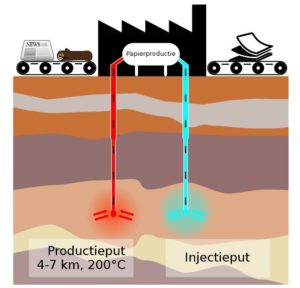
REDUCTION 2020: 0.1 MTON
REDUCTION 2021: 0.2 MTON
Solution 41 - Extra LED lighting in households - 0.2 Mton
Extra LED lighting in households
Research by Dutch organisation Milieu Centraal shows that 165 million incandescent and halogen light bulbs are still in use in the Netherlands. This amounts to an average of 24 lamps per household. The savings potential is therefore 0.9 Mton CO2. If you buy 24 new LED lamps for about €120 in total, you will save €50 annually on your energy bill for 15 years. A payback time of 2 years, which is 3 times shorter than that of solar panels. This can be implemented immediately!
There are useful websites, which allow you to find the right LED lamp with warm white light within a minute without any knowledge of lighting. See for example www.ledadvisor.eu or https://www.lampdirect.nl/keuzehulp/.
Free LED for low income families
One in five Dutch families have financial concerns. For them, the purchase of LED lamps is a hurdle that can and should be removed. With this measure we propose to give € 50 worth of LED lamps to lower income families for free. This way, a 0.2 Mton CO2 reduction can be achieved in 2020. This also helps to reduce living expenses which doubles the benefit. We propose to arrange this through municipalities, by reopening the now-closed Energy Reduction Scheme (Regeling reductie energiegebruik, RRE) for home owners and extending it to tenants.
REDUCTION 2020: 0.2 MTON
REDUCTION 2021: 0.3 MTON

Solution 42 - Stand-by killers against stand-by consumption - 0.2 Mton
Free stand-by killers
The consumption of energy in households by machines in the stand-by mode is about 450 kWh per year, according to Milieu Centraal. That’s equivalent to about €100 per household per year and a total of 1.5 Mtons of CO2 emissions. Three-quarters of this could be easily prevented with proper information and simple stand-by killers: a plug with an on/off switch and a warning light.
If the government gives each household 2 stand-by killers as a gift, it will cost them € 3 per household, leading to savings on energy bills that can amount to tens of euros per household. This solution will very likely generate public support and potentially saves 1.0 Mton of CO2. In 2020, at least 0.2 Mton can be saved if the government distributes plugs, including a clear brochure, free of charge, for example through the supermarkets.
Some appliances use energy while on stand-by or ‘off’, but with the plug still in the socket. This is called stand-by consumption. Some appliances don’t work without stand-by mode (the central heating boiler and the electronic doorbell), but a lot of stand-by consumption is easy to prevent.
450 kWh of stand-by consumption on average per household costs €100 per year (price level 2019, €0.22 per kWh). Three-quarters can be avoided by actually switching off the devices. If all computers, TVs and recorders are switched off instead of being on stand-by, each household can save 225 kWh of energy.
The government wants people to live more energy efficiently, see the campaign ‘Everyone does something’ (Iedereen doet wat). The best way to achieve this is to encourage people with practical help and to point out the financial benefits: make it easy for people by distributing the plugs free of charge at places that consumers visit almost every day. Providing clear information and pointing out the advantages (saving € 50) can stimulate actual usage of these plugs.
Cheap measure
Stand-by killers are available for as little as € 1.57. If purchased in bulk, the costs will be lower. If the price is €1.57, the distribution of 2 plugs to 7.8 million households will cost € 25 million. Because not all plugs will be used efficiently, we use a conservative estimate of 0.2 Mton of CO2 reduction. That comes down to € 83 per ton of avoided CO2, possibly much lower cost per ton. On the other hand, the potential is greater, and, with the right information, consumers may start tackling all stand-by consumption. The government can also give away just one plug free of charge and make it possible for people to purchase the second and third at a discount, or hope that the information will encourage them to more actively combat standby consumption. This is cheaper, but the effect will probably be smaller.
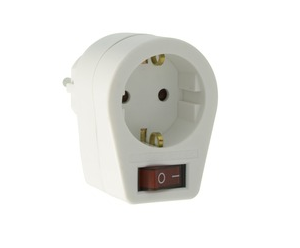
REDUCTION 2020: 0.2 MTON
REDUCTION 2021: 0.3 MTON
Solution 43 - Recycling scheme for refrigerators - 0.4 Mton
Recycling scheme for refrigerators
For most appliances, it is more sustainable to use them as long as possible and fix them when they are broken. Not so for refrigerators and freezers: they should be replaced after 8-10 years to save energy and because older models still use gases that damage the ozone layer.
The Netherlands has at least 10 million refrigerators and freezers – in households, company canteens and restaurants – of which at least 3 million are older than 10 years. 36% of the refrigerators and freezers are not properly recycled, according to figures from the National (W)EEE Register. This is a major problem because each year approximately 120,000 units that are disposed of still contain CFC or HFC. These gases have been banned in refrigerators since 2001 due to ozone depletion and their greenhouse effect, which is more than 5,000 times greater than that of CO2. If these appliances end up in the metal shredder via hardware dealers, these gases are released. Failing to properly recycle newer refrigerators also leads to harmful substances being released and raw materials being lost.
Action plan for refrigerators
This measure is two-fold: a one-off incentive for consumers to exchange their old refrigerator and freezer for a new one, and the start of a deposit system to ensure that close to 100% of refrigerators are properly recycled.
If we recycle all 3.3 million old fridges and freezers and replace them with an A++ or A+++ energy label models, we save 1.2 Mton of CO2-eq: 0.36 Mton because of energy savings and 0.84 Mton because CFC and HFC are not released and the re-use of raw materials. The proposal is to exchange 1 million old refrigerators and freezers for a newer one at the beginning of 2020 with a one-off major campaign: consumers will be called upon to return old refrigerators in exchange for a compensation of, for example, € 35 when purchasing an A+++ model. If we aim for 1 million refrigerators (1/3 of the refrigerators older than 10 years), this costs € 35 million. With this, 1/3 x 1.2 = 0.4 Mton can be saved in 2020. Each new refrigerator will lead to a saving of € 50 per on the energy bill per year.
Start of return premium system for refrigerators
If we want to move towards a circular economy, the collection rate of appliances must go up to 90-100%. The fridge is an excellent starting point for a new system, because the number of suppliers is limited and the importance of recycling is immense. With our proposal, the consumer pays a recycling contribution that is composed half of a return premium, and the remaining 50% is for circular projects and part of the operational costs of the return system.
REDUCTION 2020: 0.4 MTON
REDUCTION 2021: 0.4 MTON
Solution 44 - Stricter monitoring of F-gases - 0.1 Mton
Stricter monitoring of F-gases
F-gases are mainly used in refrigeration systems and the greenhouse gas effect is 150 to 4000 times stronger than that of CO2. Dutch emissions of F-gases are calculated at 2 Mton, of which 1.5 Mton is due to leakage from cooling systems: 1.0 Mton from stationary refrigerators and 0.5 Mton from air conditioning systems in cars. This is monitored strictly in many European countries. Whereas the regulations in the Netherlands are strict on paper, they are hardly controlled or enforced. With this measure we propose a more rigorous enforcement system, so that leaks are prevented, users switch to more environmentally friendly systems and emissions are more accurately monitored and recorded. We also propose the setting up of an extra innovation fund for the development of small installations on natural refrigerants.
Refrigerants are used in refrigeration systems and heat pumps. Often these are F gases (fluorinated gases), but natural refrigerants such as water, ammonia, CO2, isobutane and propane are also possible. F gases are synthetic and exist in many forms, many of which have been banned in recent years because of their effect on the ozone layer and climate. Some F-gases have a greenhouse effect 23,000 times stronger than CO2. As of 2020, cooling installations may no longer be made with F-gases with a GWP (Global Warming Potential) higher than 2,500. New, larger installations are already made with natural refrigerants, while old and new smaller appliances such as air conditioners and domestic heat pumps hardly ever are.
Monitoring and Enforcement
The calculation of the emission of F-gases has a large margin of uncertainty. In 2018, the Human Environment and Transport Inspectorate (Inspectie Leefomgeving en Transport, ILT) inspected a total of only 50 companies with a ‘quick scan’, 19 of which with F-gases. By way of comparison: in Flanders, during intensive inspections in 2016, leakages were found at 57% of the 97 installations inspected. Some of the leakages consisted of very potent greenhouse gases. As a result of better inspection and measurement, emissions in Belgium are estimated to be almost 30% higher than in the Netherlands, despite the fact that the country is much smaller.
Stricter controls and fines, as well as good information regarding the environmental impact of refrigeration installations, make it more attractive for end users to replace old installations sooner with more environmentally friendly ones or to retrofit old installations. This prevents leakage losses, and stimulates the conversion to installations that can use a refrigerant with a lower Global Warming Potential. Stricter measures are also needed to ensure compliance with the quota system stipulated in the F-gases legislation and to suppress the growing illegal trade in F-gases. The Flemish policy can easily be copied in this way.
Innovation for smaller devices: Now that the energy transition is accelerating and more households are switching to heat pumps, it is important to accelerate the development of small appliances with natural refrigerants and to provide good information about purchase and maintenance.
Ban on production of R22:
One of the important principles that underly the Climate Accord which was recently closed is to prohibit export emission across borders. A ban on the production and export of R22 (a HCFC) to developing countries is therefore only logical. This is already the case in the rest of Europe.
Innovations
Large installations, for example in supermarkets, are nowadays made with natural refrigerants. For smaller installations, this only happens sporadically, as in the case of small heat pumps and household air conditioners. These two devices have been sold more often in recent years. One new air conditioner deserves attention here: the ICECUBE from DCS.cool: it uses water as a refrigerant and is more energy-efficient than many other air conditioners.
As the climate is heating, and more and more households are buying air conditioners, it is important to speed up the development of small appliances using natural refrigerants, and to provide good information about purchase and maintenance.
PS
In addition, we would like to point out that 1 tree has the same cooling effect as 5 air conditioners and captures CO2 instead of producing emissions. Green roofs also cool and prevent emissions from air conditioning. In education and for new housing estates, this must therefore be fully utilized.
REDUCTION 2020: 0.1 MTON
REDUCTION 2021: 0.4 MTON


Solution 45 - Reduce nitrogen fertilizers in agriculture - 0.2 Mton
Reduce nitrogen fertilizers in agriculture
Nitrogen fertilizers account for about 8% of the country’s nitrogen emission and almost 2 Mtons of CO2-eq emissions. The production and use of nitrogen fertilizer causes severe climate damage due to the emission of nitrous oxide, methane and CO2 eq.
1 kilo of nitrogen equals 8 kilo of CO2 eq. A 10% reduction already saves 0.2 Mton.
The damage to nature caused by nitrogen fertilizers is considerable. This is amplified by the extensive use of protein-rich feed for livestock which causes the amount of nitrogen in manure and the environment to be very high. An agriculture that is in balance with nature and in which the soil is the central focus solves many problems, but requires a long-term vision and consistent policy for the next 10 years. Nevertheless, measures can already be taken in 2020 (in addition to solutions 2, 3, 10, 11, 12, 22, 27, 31, 35) that are in line with long-term plans for a circular agriculture.
Nationwide pilot with 240 new soil-farmers and information on healthy soils
We propose to open a fund of € 2.4 million with which a national network of some 20 soil experts will work with 20 farmers per province (voluntarily). Under supervision, the agro-chemicals per farm will be reduced to 15% of the original use within 5 years. The soil will become healthier and will absorb more CO2. This fund will also co-finance a second edition of the Soil Food Week with symposiums and workshops for farmers, plus the opening of a Soil Knowledge Centre, an initiative of the Biosintrum in Oosterwolde and the Soil Knowledge Consortium.
Precision fertilization and the use of circular fertilizers
A rapid reduction in the use of nitrogen fertilizer can be achieved, by no longer generously spreading fertilizer on the land, but switching to precision fertilization. With precision fertilization, only the right plant nutrient is administered, at the right time, in the right dosage and in the root zone. About 20% of farmers are already experimenting with this method. This figure could be doubled by taking several measures that are aimed at education, information and changes in regulatory schemes regarding fertilisation processes. In addition, the following measures could be taken:
Governments and supermarkets as a driving force
– The government (from research institutes to the municipal level to canteens in central government ministries) should only purchase from farmers with lower nitrogen emissions. This applies to canteens, but also to site management agencies. For example, as of 2020, all agencies should opt for organic flower bulbs.
– the Central Bureau for the Trade in Food (Centraal Bureau Levensmiddelenhandel, CBL) has recently indicated to Minister Schouten that they want to help with the transition to circular agriculture. This is a good opportunity to make a significant shift towards more sustainable products on the shelves in supermarkets in 2020 with more Dutch products for which less artificial fertilizer has been used. Supermarkets should increase their demands regarding the use of cattle feed (less concentrates, no soy from outside the EU), and outdoor grazing.
Agricultural education is fully committed to change
Pilot farms of Wageningen University & Research and other institutes should fully switch to precision fertilization with circular fertilizers and/or organic manure. They should also become fully committed to reducing fodder that is based on non-European soy.
Remove obstacles for the organic sector
The organic sector sees many opportunities for better soil management, but is hindered by legislative hurdles. These hurdles should be removed. When fertilizing, the most important factor is to include the entire manure system from production to effect on the soil, because that gives opportunities for the best manure: pot stable manure.
REDUCTION 2020: 0.2 MTON
REDUCTION 2021: 0.3 MTON
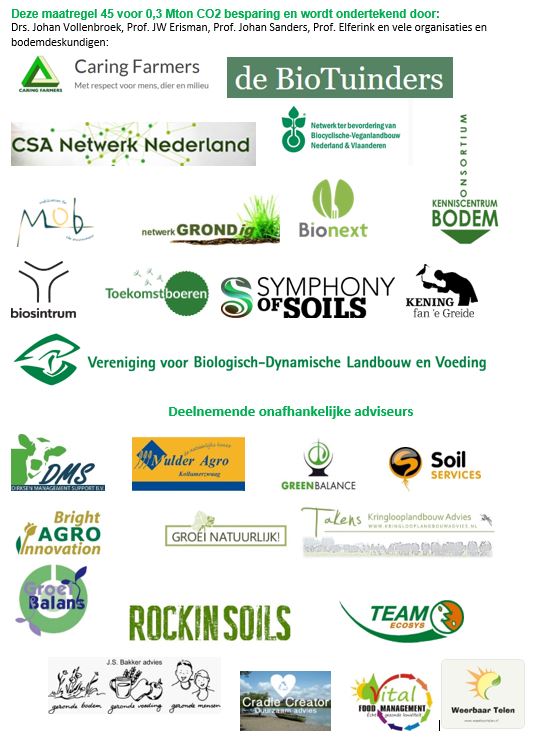
Solution 46 - Close the door - 0.3 Mton
Close the door!
Open shop doors in winter use as much energy as 180,000 return flights to Hong Kong, according to the national daily De Volkskrant in 2016. In the same article, a shopkeeper from Amsterdam says that a smart sliding door saves as much as €4,500 on the energy bill. Nevertheless, most shopkeepers keep their doors open all winter, because they are (unjustifiably) afraid that customers may otherwise not enter the shop. Municipalities can force shopkeepers to keep doors closed via local regulations, but this is not yet implemented in any city. With solution 44, we propose to have store and industrial doors closed compulsorily, unless they have a system that reduces energy wastage, such as revolving doors, draught locks, smart sliding doors or air curtains. This would be counterbalanced by government loans to shopkeepers who want to invest in these facilities. For larger companies, enforcement of the Environmental Management Act is desirable. This solution will save at least 0.3 Mton in 2020.
One door: 10 tons of CO2
In 2010, researchers from Cambridge calculated that one closed shop door annually can save up to 10 tons of CO2, the equivalent of 3 return flights between London and Hong Kong. In the same year, a sample drawn up by energy consultancy bureau Ecofys showed that about 60% of shops (about 60,000) in the Netherlands leave their doors open. Shopkeepers think that they will lose customers if they keep the doors closed. However, research shows no clear decrease in shop visits when the doors are closed. Since 2010, many stores have been fitted with air curtains, but according to Sustainable SME, many of these are not properly set up. Municipalities can ask or force shopkeepers to keep the doors closed. A few municipalities have tried to have shopkeepers do this voluntarily, but no Dutch municipality enforces it. A good example is New York: shopkeepers are fined $1,000 if they waste (air conditioning) energy in the summer by leaving the doors open.
Air curtains at companies
Many other large companies also have their doors open. They are obliged to take all environmental saving measures with a payback time of less than five years, like air curtains. But again, this environmental law is not enforced by authorities. Better enforcement and fines could save a lot of CO2.
REDUCTION 2020: 0.3 MTON
REDUCTION 2021: 0.4 MTON

Solution 47 - A more ambitious plastics plan - 0.2 Mton
A more ambitious plastics plan
Plastics! We want to get rid of them, because they pollute the environment and kill many animals. On top of that, the production of plastics leads to a lot of CO2 emissions. There are plans to improve recycling and to increase the use of bioplastics. The share of recycled or bioplastic in the production of plastic is currently about 15%. By 2030, this should be 45%, which would ensure an emission reduction of 2.3 Mton CO2.
Solution 47 proposes more ambitious targets to reduce the production of new plastics and achieve the 45% target for bio/recyclable plastics by 2025. This will result in savings of at least 0.2 Mton by 2020.
Translate plans to action
The government also wants to reduce the amount of plastics and states: “The use of (mostly) fossil raw materials and energy puts pressure on the environment. The spread of plastic litter and microplastics on land and in the sea results in a growing pollution of the ecosystems”. For the government, the ‘Transition Agenda Circular Economy – Plastics’ is leading, but policy has not yet determined how this will be realized. Also the intended CO2 emission reduction is not very clearly defined.
Double the pace
The government should double the intended pace by gradually introducing a mandatory share of biobased and/or circular plastic in all plastics used in the Netherlands from approximately 15% now to 45% in 2025, with an intermediate target of 30% in 2022. In 2022, this would save about 1.2 Mton CO2, and in 2025 about 2.1 Mton. In 2020, the first 0.2 Mton can certainly be realized. Acceleration will also help achieve the 2030 targets.
REDUCTION 2020: 0.2 MTON
REDUCTION 2021: 0.5 MTON
Solution 48 - Two innovations in the transport sector - 0.2 Mton
Two innovations in the transport sector
Together, two innovations in the transport sector could save 0.2 Mton CO2-eq in 2020. Firstly, a new sealing gel Ride-On ensures that air pressure in tyres is maintained, reducing the risk of punctures. Flat tyres are a major cause of traffic jams and as the Dutch transport sector suffered €1.4 billion worth of damage from traffic jams in 2018, it should embrace this gel. Another innovation is the SolarOnTop solar panel system for trucks from IM Efficiency. These save a lot of fuel by eliminating the need for the alternator to generate power during the trip. Additionally, it is also no longer necessary to leave the truck idling to generate electricity.
Sealing tyres with Ride On
The Minister for the Environment and Housing, Stientje van Veldhoven, said: “If all cars were to drive around with the proper tyre pressure, we would save about 0.4 Megatons of CO2 per year in emissions”. There are two ways to keep tyres inflated: by regularly inflating them (solution 25) or by sealing them. Both solutions have their own advantages.
Ride-On’s tyre gel is applied once to new tyres or via the valve to tyres that are already on the rim. This allows the tyre to remain at a better pressure for a long time and thereby saves fuel. It requires less discipline from drivers than regular inflation. Also, the tyre does not puncture as easily, resulting in fewer traffic jams. The tyre lasts longer and reduces emissions. The Ride-On tyre sealer also has a balancing effect, as confirmed by an RDW test. There are initial costs associated with using the gel, but these are recouped through lower fuel consumption.
Sun on trucks through IM Efficiency
Starting in March 2020, Start-up IM Efficiency wants to equip the first Dutch trucks with its SolarOnTop system, followed by freight traffic in other European countries. Calculations show that the solar panels of the SolarOnTop system can yield fuel savings of up to 5.5%. Because the alternator no longer needs to generate electricity and the engine is subjected to less load, this saves an average of 2,300 litres of diesel per truck per year. As a result, a truck emits 6 tonnes less CO2 each year. The investment pays for itself after about 3 years. An additional sustainable advantage is that the batteries of trucks and trailers have a longer lifespan because the SolarOnTop cleverly charges the batteries and keeps them healthy. Currently there are transporters who replace their batteries every 6 to 12 months.
SolarOnTop is now first developed for semi-trailers with a hard roof. Some 44,500 of these are in circulation in the Netherlands. If all these cars are equipped with the system, this will save more than 267,000 ktonnes of CO2 per year. If all suitable trailers are fitted with solar panels as soon as possible from March 2020, savings of at least 0.1 Mton and perhaps 0.2 Mton will be feasible in 2020.
The start-up IM Efficiency can quickly scale up. The obstacle lies within the transport sector: many companies cannot afford the initial investment of around € 6,500 per semi-trailer. A subsidy of, for example, € 500 in combination with a cheap loan for the rest of the amount provides help and acceleration.
REDUCTION 2020: 0.2 MTON
REDUCTION 2021: 0.2 MTON
Solution 49 - Green and healthy living - 0.1 Mton
Green and healthy living
Greening cities provides cooling, better drainage, cleaner air, more biodiversity and happier and healthier people. And it’s important for CO2 storage. Yet many existing housing estates are very heavily paved, the Netherlands fails to meet its biodiversity targets, our air is heavily polluted by too much nitrogen oxide, and climate change calls for more green space. We urgently need to make existing neighbourhoods greener and include green space in large-scale new-build plans from the outset.
With this solution we propose:
- Each new home will have 75 m2 of park within a radius of 500 meters.
- This way we create an extra area of nature the size of the Veluwe (a Dutch nature reserve) in our backyards by removing tiles.
- We remove tiles and replace them with trees, grass or plants in 3% of public space and business parks.
- Citizens are stimulated and supported by local ‘green-blue’ education support teams.
CO2 emissions will not fall much in the first year, 0.1 Mton, but the long-term effects will be considerable. This solution is necessary to achieve the biodiversity and climate targets for 2030. Greening cities also means healthier people and lower healthcare costs. Plus more cooling, so it prevents the purchase of air conditioners that emit CO2.
75 m2 of green space for new housing
The Netherlands is going to build 75,000 houses in 2020 and in the years thereafter. We propose to:
- Use the old standard of the Ministry of Environment of 75 m2 of green space per house (parks). With 75,000 homes, 5,626 hectares of urban nature will be added each year. The Climate Agreement includes ‘more forest’ in 2030, but no specific details are given as to how this will be achieved. With this measure, we are giving it substance: 56,000 hectares of new nature by 2030 in the form of woodlands and parks. The construction of this forestry will cost about € 2 billion over 10 years. Calculated per house, this is € 2,000. This can be included in the selling price.
- Nature-inclusive building will be the new standard. There is broad support for this in society.
Replace tiles with greenery
The Netherlands has about 246 km2 of paved garden, especially in urban areas. The gardening industry (De Tuinbranche), IVN and WNF (WWF) intend to jointly replace the tiles in our yards of a combined area as large as the Veluwe, with plants, grass and trees within five years. At the end of March they are planning a major campaign to hand in tiles in exchange for free plants. Research has shown that this is the best way to get consumers involved.
By supporting this campaign with €800,000, all garden centres in the Netherlands will be able to participate and a major information campaign will be mounted, saving 0.036 Mton in 2020.
The Netherlands has 153 km2 of car parks, 800 km2 of business parks and many other paved areas where it would be possible to create greener neighbourhoods, business parks and shopping areas. The government should ask all municipalities to get rid of 3% of all pavement next year.
REDUCTION 2020: 0.1 MTON
REDUCTION 2021: 0.2 MTON
Solution 50 - Tidy up your data - 0.5 Mton
Tidy up your data
Data centres in the Netherlands emit 6 Mtons of CO2 at a consumption of 13 billion kWh/year. If you add to that the emissions from all small servers in offices, the emissions from our data traffic is considerably higher. Data traffic is increasing with the increasing popularity of streaming services. Still, we can save a lot in this industry in 2020: by putting servers on eco mode, by cleaning up data and by green hosting of our websites. With this measure, we propose that the government will firstly get to work itself and secondly launch a major public campaign for National Data Clearing Days.
With this measure we propose the following:
- Encourage more servers to be put on eco mode, following the initiative of the municipality of Amsterdam.
- Organise National Data Clearing Days: every 500 TB cleared from a cloud service saves 1,000 tonnes of CO2-eq.
- Ask all government agencies to clean up data on a regular basis and put infrequently used data on stationary servers.
- Implement green hosting for all government websites.
- Install Ecosia as a green search engine on government computers (instead of Google for example which stores too much data).
REDUCTION 2020: 0.5 MTON
REDUCTION 2021: 1 MTON
This measure owes a lot of data to the Super Sustainable Students: read their tips on how to use data more economically here.
Solution 51 - Anaesthetizing differently - 0.1 Mton
Anaesthetizing differently
The Dutch healthcare sector emits 11 Mtons of CO2, about 7% of the total national CO2 emissions. The causes are mainly energy consumption in buildings (38%), transportation (22%) and (the production of) medicines (18%). The fact that hospitals consume energy cannot be prevented. It is a requirement of patients who need clean beds, a warm environment and medication. Yet, emissions in healthcare can be significantly reduced. For example, by behavioural changes (measure 4, Energy battle in healthcare). Measure 52 proposes to opt for more environmentally friendly anaesthetics and to lower the air treatment installations of the operating rooms when they are not being used.
1. Replace inhalation gases and vapours with intravenous anaesthetics where possible.
To put (and keep) people asleep before surgery, anaesthesiologists now have the choice between intravenous anaesthetics and inhalation anaesthetics. Both work similarly and medically there is hardly any difference between patients who have had vapour anaesthesia or intravenous anaesthesia. The cost is roughly the same for both drugs. It is estimated that they are used equally as often and the choice is often based on the anaesthesiologist’s personal preference. However, there is a substantial difference between the effect that both drugs have on global warming. For example, the commonly used type of anaesthetic gas Desfluane is a 2,540 times stronger greenhouse gas than CO2 (GWP = 2,540). Instead of Desfluane, another anaesthetic gas can also be used, such as Sevoflurane, which is ‘only’ 130 times stronger than CO2. Even better for the environment is the intravenous drug Propofol. The OLVG West hospital in Amsterdam stopped using Desflurane at the beginning of November 2019, while the OLVG East hospital in Amsterdam has not used it for years. The annual CO2-eq reduction at these two hospitals is 88 tons.
2. Turn down the air treatment installation of operating rooms when not in use.
In the operating room (OR) the air quality requirements are high: the air has to be changed 20 times per hour. As a result, it takes a lot of energy to keep the temperature, humidity and overpressure constant. When the installations are switched off in ORs that are not used during evening, weekend and night shifts – about 50-60% of the time – energy consumption decreases by 50%. The Amsterdam Medical Centre adopted this measure in October 2018 and saved around 400,000 kWh per year, which is comparable to the electricity consumption of 100 households. If all hospitals with operating facilities in the Netherlands were to do this, we would save 0.01 Mton CO2 per year, without any investment.
REDUCTION 2020: 0.1 MTON
REDUCTION 2021: 0.1 MTON

Solution 52 - Optimizing voltage - 0.5 Mton
Optimizing voltage
In the Netherlands, the average voltage level (230 Volt) is higher than the optimum voltage for appliances: at 220 Volt they consume less energy and last longer. Anywhere where the mains voltage is higher than 227 Volt on average, voltage optimisation can save energy. The savings can be as much as 15%. There are various devices that can do this, such as Powerstar and Kubie, of which one is more suitable for industry and the other for households. With solution 52, we propose that the government takes stock as soon as possible of the large governmental installations – such as pumping stations and water treatment plants – in which voltage optimisation is a worthwhile investment. The government can also speed this development up by providing information, by admitting the appliances to the Recognised Energy Conservation Measures list and by starting a large-scale project for consumers together with the grid managers.
Optimal mains voltage
The Netherlands has a stable electricity network. Nevertheless, in more and more places the mains voltage is higher than strictly necessary, which means that many appliances consume more electricity than necessary. All European appliances can operate on a mains voltage between 207 and 253 Volt. But just as a car is the most energy-efficient and efficient to drive at 80 km/h in fifth gear, many devices also have a mains voltage that allows them to function optimally. If the average mains voltage is around or higher than 227, voltage optimisation is an interesting investment. Devices that heat, such as a kettle, can make good use of the excess voltage, but most other devices – especially pumps, air conditioners and refrigerators, but also computers and lighting – operate less efficiently at a higher voltage.
All companies that have large air installations or pumps and do not frequently work with direct current are advised to consider optimisation when the average mains voltage is high. Think of water treatment plants, data centres, supermarkets and swimming pools. But homes can save a lot of money too.
In the future, our electricity grid will increasingly experience peaks and troughs due to an increase in wind and solar energy. Here too, voltage optimisation will help, for example by storing excess voltage in batteries. The aforementioned devices help with the peak load of solar panels and prevent problems with inverters. The Powerstar can also store the saved electricity in batteries. Kubie, when ordered in large quantities by the government or through the grid managers, could provide households with a 10-15% lower energy bill for €300-400.
REDUCTION 2020: 0.5 MTON
REDUCTION 2021: 2 MTON
Solution 53 - Restrictions on veal calve, goat and sheep industries - 0.2 Mton
Restrictions on veal calve, goat and sheep industries
The government is allocating €180 million to reduce the Dutch pig industry in order to reduce CO2 and nitrogen oxide emissions and smell. At the same time, the veal calf, goat and sheep industries, which together account for more than 2 Mton of CO2 emissions, are growing. Whereas measures 2 and 22 concern the dairy and pig industries, with this measure we also propose to down-size other animal sectors, preferably while retaining as many farmers as possible. This measure also contributes to solving the nitrogen oxide problem.
The Netherlands has 17 million people and it has 118 million animals in livestock farming. This is more than our environment can cope with, as evidenced by our level of nitrogen oxide pollution. But it also leads to animal welfare problems and problems for human health, such as antibiotic resistance and zoonotic diseases, like Q fever. Yet the goat industry – despite Q fever – has grown by 4.5% in the past year. The sheep sector grew by 6% and the number of veal calves by 4%. The decrease in the number of calves born in the Netherlands is completely offset by a large increase in calves imported from abroad. The import of about 800,000 of these young animals each year puts pressure on Dutch farmers. Reducing the import of these animals is supported by the farming sector.
Actions to be taken
- Open a transition fund for farmers to convert to more ‘Better life’ stars or to organic farming. This will allow farmers to reduce the number of animals and still practise their profession. At the same time, talk to the supermarkets about increased sales of animal friendlier products.
- Set national caps for veal calves, horses and ponies, sheep and goats, rabbits, ducks, camels and animals used for fur.
- Limit the transport time for young calves. Fetching calves from Ireland and Latvia is not animal-friendly and is bad for the climate.
- The Dutch Food and Consumer Product Safety Authority has greatly scaled down in recent years. Its capacity should be scaled up again with the aim of conducting stricter enforcement on transport, manure regulations and animal welfare standards including air quality and rooting materials.
- Establish a standard for the minimum living space for goats. The sector can now expand by keeping more goats as well as by keeping more goats per square meter.
- Open an exit scheme for all livestock sectors. Help farmers without a successor with a generous quitting arrangement.
- Discourage business takeovers by skimming off the rights to keeping animals in the event of business takeovers. This way, farmers that leave the business will not lead to an increase in the scale of farms, but to shrinkage in the industry.
REDUCTION 2020: 0.2 MTON
REDUCTION 2021: 0.3 MTON
Solution 54 - Extra SDE+ subsidy for solar energy on roofs - 0.5 Mton
Extra SDE+ subsidy for solar energy on roofs
Over the past autumn, thousands of solar roof projects that could have been realised in short order were rejected because of the depletion of the SDE+ budget (a subsidy scheme). These projects would have contributed to bringing renewable energy targets within reach. We are therefore arguing for a retroactive increase of the budget from last autumn, so that solar roof projects can still be realised. It is estimated that this will result in an indicative 0.5 Mton CO2 reduction and an additional 1.5 TWh of renewable energy in 2020, at a cash expense of €55 million per year.
The heavily over-subscribed SDE+ subsidy autumn round of 2019 shows that the interest in solar PV projects is consistently increasing. A total of 7,251 applications were submitted (representing 4.4 TWh /year). This concerns mostly solar projects on roofs in addition to solar projects on land. It is estimated that some 6,000 ready-made initiatives for solar roofs that would fit into the electricity grid (good for 2.5 TWh/year) will not receive an SDE+ decision, because large-scale solar fields on agricultural lands are favoured by the scheme.
Solar power on rooftops first!
Solar PV on roofs is at the top in the preferred order of the new ‘solar ladder’, as laid down in the (concept) National Strategy on Spatial Planning and the Environment. By retroactively allocating the SDE+ budget to all the applied sun-on-roof projects and giving priority to solar power on roofs according to the Solar Ladder, natural and agricultural lands will be saved.
Raising the budget now will save money later
Failing to meet the EU sustainable energy targets is going to cost the Dutch government a lot of money because of the fine announced by European Commissioner Timmermans and because of the purchase of empty ‘statistical transfers’ abroad. The thousands of rejected solar roof projects offer an excellent opportunity to prevent or limit this fine. Under the SDE+ scheme, solar roof projects must be completed within a year and a half. With a little extra effort, some of them can even be carried out within a year. An extra impulse of €55 million now, pushes up the share of renewable energy in total energy demand by 0.3%. The costs per avoided tons of CO2 are € 110.
In addition: extra SDE+ budget for solar energy on distribution centres
In addition, an increased SDE+ budget in 2020 could ensure that in the coming year many roofs of distribution centres will be fitted with lightweight thin-film solar panels. This is a relatively new and promising innovation from the Dutch company HyET Solar, which should now finally be scaled up to generate solar energy even on roofs with lower structural integrity.
The Netherlands has 1,930 distribution centres with a joint shadow-free and available roof surface area of some 19.3 million m2. The lightweight thin-film panels can be used for all those distribution centres where placement of traditional panels is impossible. Thanks to a more complete coverage of the available roof area, these thin film panels can provide 20 to 50% more energy per roof compared to traditional panels. If 40% of the shadow-free roof surface of distribution centres is covered with thin film panels, this could result in a 0.1 Mton CO2 reduction by 2021. With an additional SDE+ budget for solar roofing, the first 0.03 Mton can be saved in 2020.
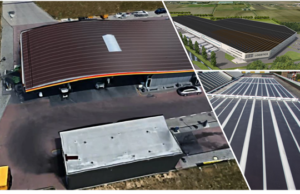
REDUCTION 2020: 0.5 MTON
REDUCTION 2021: 1 MTON



